

VIP Doge's Palace Secret Passages Tour

- Gain special access to areas of the Doge's Palace not usually open to the public—including torture chambers and Casanova’s prison cell!
- After your secret passages tour, you'll skip notoriously long general access lines to get inside the Doge's Palace for a special tour by our local guide.
- With a small group of just 20 guests, your journey will be intimate, while privileged access means you won’t waste any time waiting in line.
Preview the experience
Tour description, with special access, you'll see more of the doge's palace than most other visitors..
Away from the grandiose halls and lavish apartments of the Doge's Palace lies a darker side to the space. On this Doge's Palace secret passages tour, you'll step off the beaten path and into the shadows, discovering the secrets and spaces that the Venetian doges themselves tried to keep hidden.
You’ll meet your guide near the Doge’s Palace and head straight inside (no waiting in line for you) where a palace guard will unlock a secret door, allowing you to step into the hidden world of political Venice. Navigate the hidden prison cells reserved for VIP prisoners, torture chambers, secret government archives and top echelon offices. Even back in the day, most Venetians didn’t know this space existed, so it’s hard to overstate just how privileged our secret passages tour is. With their antique cabinets and creaky floors these rooms will truly make you feel as if you’ve stepped back in time.
By exploring the secret passages, you get away from the crowds elsewhere in the Doge’s Palace and walk in the footsteps of Venice’s most colorful characters. Our favorite? Casanova, that legendary romantic—yes, he did exist! And, as you’ll learn, he deserves all of the lore. Against all odds, he was able to escape his cell here in the palace—a cell you’ll get to see exclusively in the secret passages tour.
See secret passages and stunning ballrooms at the Palazzo Ducale.
Few visitors ever have the opportunity to walk the passages you’ve just walked, yet the Doge’s Palace is still one of the top sights of Venice. See what all the fuss is about when you step back into general access areas of the palace to explore the waiting rooms, council halls and ballrooms of the palace. While our secret passages tour is full of dark secrets and hidden rooms, the general access part of this tour is all pomp and grandeur, offering glimpses of Venice’s finest works of art.
You’ll discover the public face of the Republic of Venice with your expert guide, from the Doge’s own lavish apartments to the Hall of the Great Council. Admire beautiful and dramatic paintings by Veronese and Tintoretto, and explore the magnificent halls that demonstrate the prestige of the Venetian Republic.
Small groups, special access, and local guides make for an unforgettable tour.
Throughout your tour, you’ll travel in small groups of only 20 people or less, so you’ll find that your guide is always easy to hear and engage with. Ask all the questions you want—our guides are locals who spend a lot of time in the Doge’s Palace, so you’ll find it hard to catch them out. They’re passionate about the history and art of Venice, and about sharing that passion with you, so they’d love to hear your queries.
With privileged entrance, you'll save time that would have otherwise been spent waiting in line, while special access allows you to go far beyond the usual visitor experience for an adventure into the Doge’s Palace secret passages. Leave no stone unturned or door unopened on this complete, comprehensive, and thoroughly VIP exploration of the history and art of Venice!
Please note that due to Doge's Palace rules, we cannot accommodate children under six years old in the Secret Passages.
Sites visited
Verified guest reviews, may 02, 2024.
Francesca was absolutely the best tour guide we’ve ever had, she was very knowledgeable and funny at the same time. After the Doges Palace tour she went above and beyond to help us get skip the line tickets for Saint Marks Basilica after our tour that we booked thru Walks got canceled and it was too late to book another tour.
Fascinating to walk the secret tunnels and view what other people would normally not see, for example Casanova’s cell’s and the stories behind his imprisonment, are they true or is he just a great story teller?
Apr 28, 2024
The Secret Passages of the Doges Palace in Venice was a great tour and our tour guide, Mat, was very good. A couple of things to note: there are a lot of stairs and narrow staircases and the audio equipment does not work well in the dungeon portion of the tour due to the winding passages and thick walls. If you are not at the front of the group near the guide, you miss a portion of the commentary. Still enjoyed the tour very much.
Oct 15, 2023
Our tour was outstanding. Our guide, Maria Terese was so knowledgeable and funny. Highly recommend.
Tour guid walked too fast and did not keep group together very well
Know before you book
Make it a perfect day.
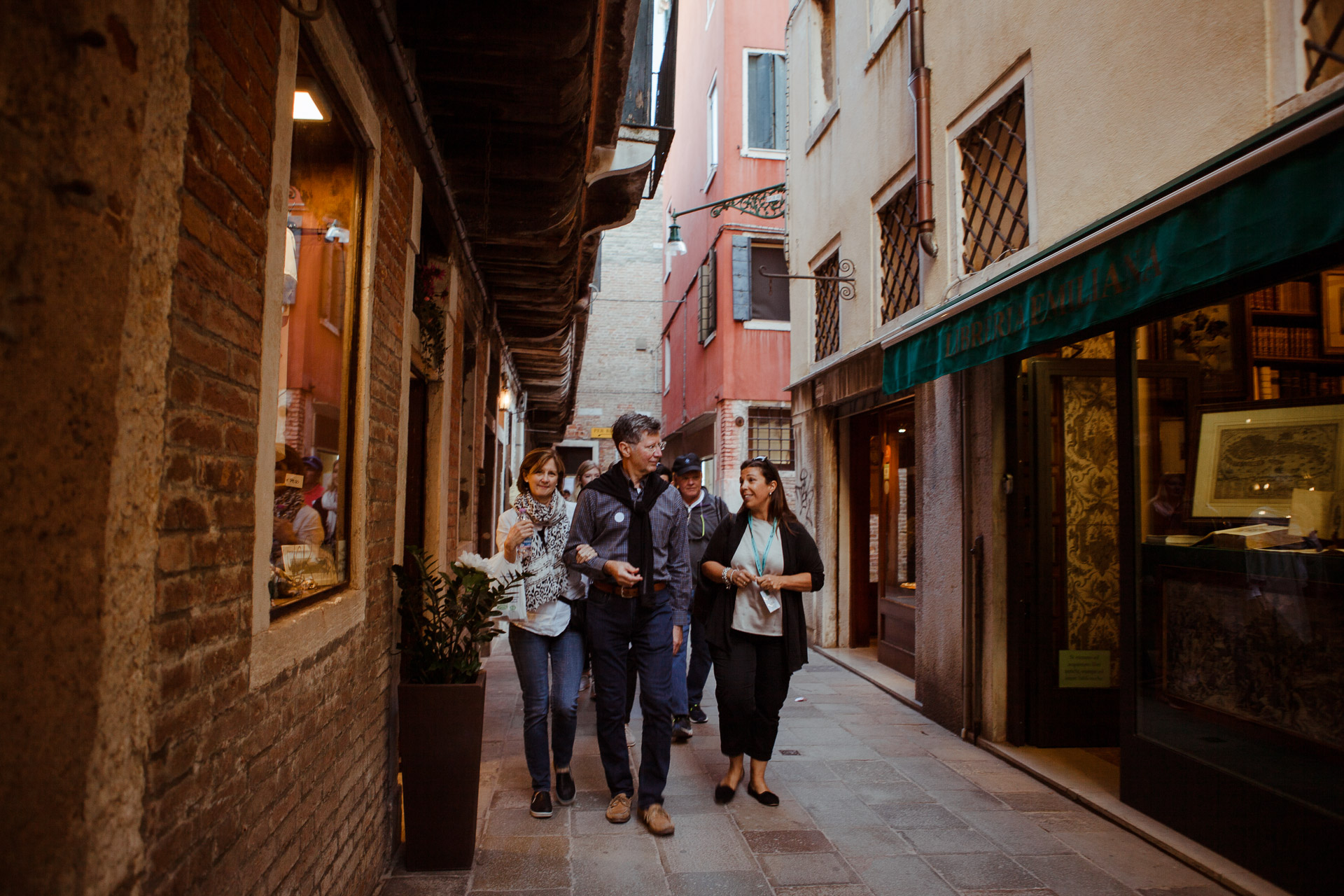
Spend a perfect day in Venice exploring iconic local attractions and tasting the best cicchetti in the city on an evening food tour.
Similar tours
Exclusive alone in st. mark’s basilica after hours, legendary venice: st. mark’s basilica with terraces & doge’s palace, exclusive alone in st. mark’s & doge’s palace tour.
Contact Information

- Help Center
- Terms & Conditions
- Cancellation Policy
- Health & Safety
- Privacy Policy
- Cookie Settings
- Travel Agents
Doge’s Palace Venice Prisons: History and Tour
Are you curious to discover the prisons of the Doge’s Palace in Venice? Do you want to know how trials were held, where the inmates lived, and how to visit the prisons?
You have come to the right place. I am Paolo from Palazzoducalevenezia.com, and in this article I will tell you about the prisons of the Doges’ Palace.
You’ll find out what the Pits and Piombi are, how trials were held, how inmates were treated and where they were locked up, and you’ll find out how to buy a ticket to the prisons.
Before we begin the article, a brief introduction; if you wish to visit the prisons of the Doge’s Palace Venice, you have two options:
- Purchase the ticket to the Doge’s Palace : that is, the entrance ticket to the Doge’s Palace, which allows you to enter the Palace, visit all the rooms and have a look at the prisons;
- Purchase the ticket for the Secret Itineraries of the Doge’s Palace tour : this ticket allows you to discover, together with a tour guide, the entire Doge’s Palace and take a very in-depth look at the most hidden rooms and prisons in Venice.
If you are interested in discovering the history of the Palace and taking an in-depth look at the prisons , I recommend that you buy the entrance for the Secret Itineraries ; if, on the other hand, you want to make a cursory visit to the prisons and have little time for your visit , you can opt for the standard ticket . In both cases, however, I recommend that you purchase the ticket online , to avoid the long lines that may form at the ticket office.
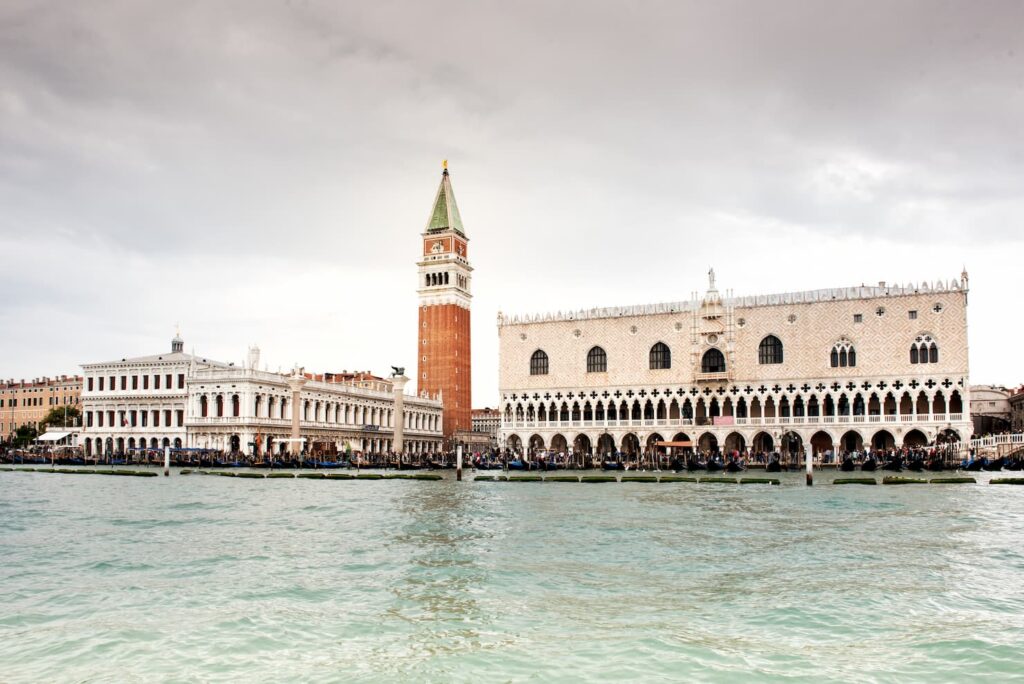
Visit to the Doge’s Palace and Prisons Venice: tickets for the Doge’s Secret Itineraries
Purchase online. Choose your preferred time. Visit Venice’s Doge’s Palace, Bridge of Sighs, prisons and more. You can cancel for free up to the day before your visit.
Well, after this introduction, we are ready to begin our journey inside the prisons of the Doge’s Palace in Venice. Are you ready? Let’s get started!
Table of content
- 1 The Palace of Prisons in Venice
- 2 Venetian Justice
- 3.1 The Pozzi
- 3.2 The Piombi
- 3.3 The New Prisons
- 4.1 How to see the prisons in Venice?
- 4.2 In which rooms was justice administered inside the Doge’s Palace of Venice?
- 5 Prisons of the Doges’ Palace: conclusions
The Palace of Prisons in Venice
The interior of the Doge’s Palace housed many places of detention, mostly concentrated on the ground floor in cramped spaces that were meant to accentuate the prisoners’ punishment.
After the Prisons were built, only two areas for prison purposes survived:
- the Pozzi , close to the canal, damp, dark, unhealthy, with vaults so low that no upright posture was possible;
- the “ Piombi ” (“leads” in english), located in the attic, named after the metal of the roofing slabs, where the temperature reached extremes, very cold in winter and muggy during summer.
Are you curious to know how prisoners’ life was carried out during the strict Republic of Venice ?Let’s get started!
Venetian Justice
Inside the Doge’s Palace in Venice, justice was administered , and all judicial, civil, and criminal proceedings took place. Venetian justice was very strict, and trials could also begin as a result of anonymous complaints mailed into special marble lion mouths, real mailboxes.
The court cases were analyzed and discussed in the austere Upper Chancery Hall (located at the square Atrium and the Golden Staircase room). This hall was located in a place that was not easily accessible in the Palace and could be visited via the Secret Itineraries route .
On the walls of the hall were the cabinets that held the public and secret acts of the Venetian magistracies, including the secret archives of the Council of Ten , a much-feared body in Venice along with the magistracy.
Next to the Chancery Hall was the torture room, also called the “ Torment Chamber ,” entirely lined with wood and with a very high ceiling. The most common technique for extorting confessions from prisoners was the “ rope method ,” prisoners’ hands were tied and slowly pulled up until they found themselves hanging in the void. A balcony runs around the room; the prisons faced right onto it so that inmates could hear the tortured men’s screams of torment so that they would immediately admit their guilt.
Equally dreadful was the so-called “ drop torture ,” by which the inmate was immobilized in a chair for hours on end while an icy drop fell on his forehead without his being able to rest or sleep, until he went insane.
Torture , at any rate, was always practiced in mild form in Venice and was gradually abandoned from the seventeenth century onward.
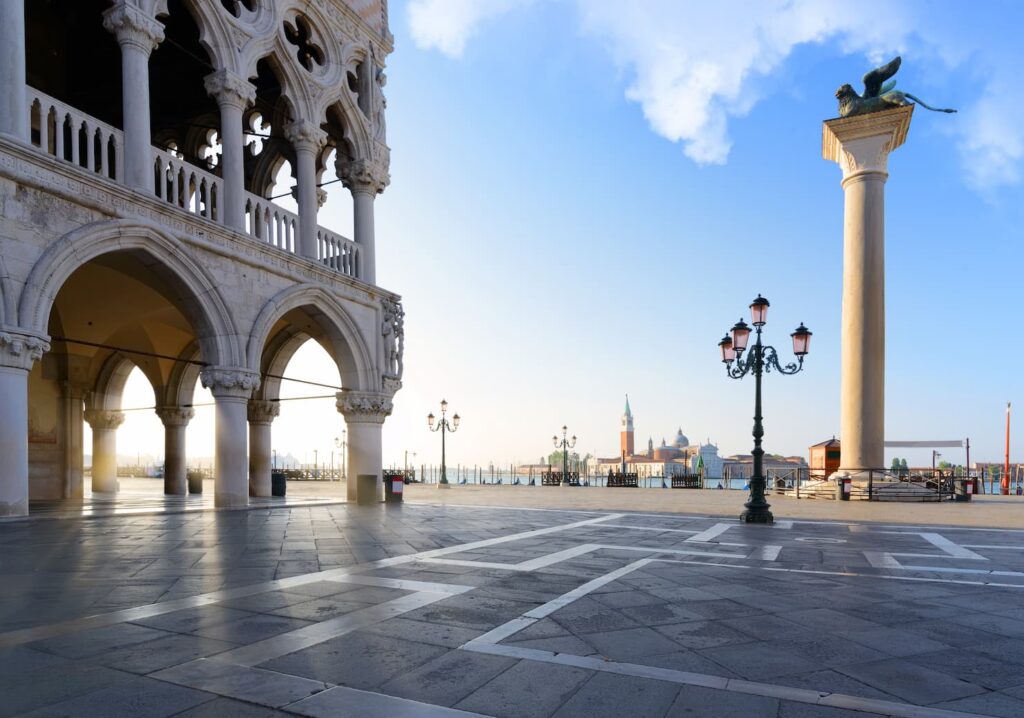
The prisons of the Doge’s Palace in Venice
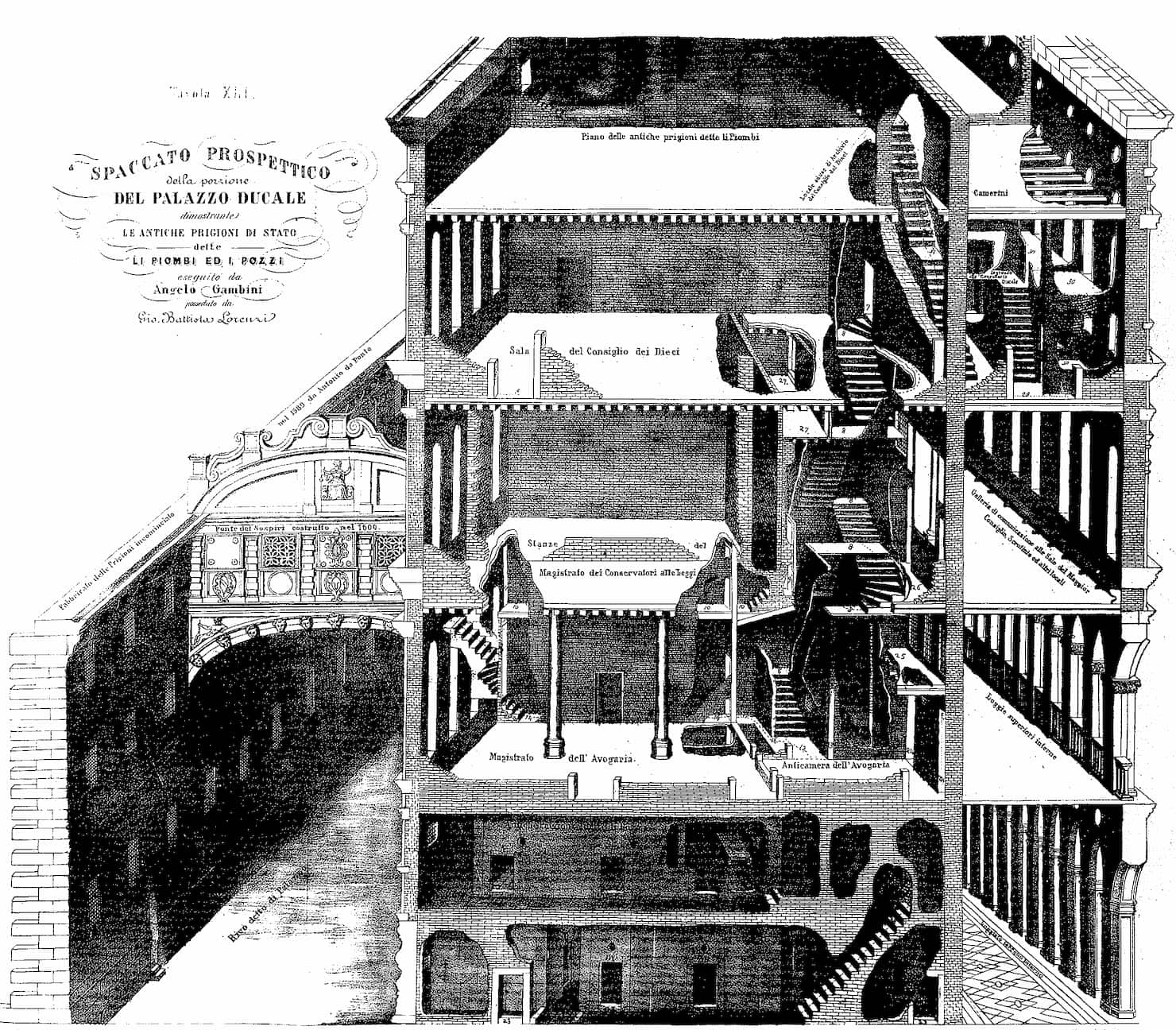
Once judged and found guilty, inmates were escorted to the prisons .
If the crimes were minor , these were served in the neighborhood prisons, that is, of the various “ Sestrieri ” (neighborhoods) of Venice.
Each had its own, also depending on the type of crime, for example, debtors were entitled to the prisons of St. Mark’s, located at the “Mercerie”, while war enemies were entitled to the “ Gabioni of Teranova ”, on the Schiavoni shore.
More serious crimes , on the other hand, were served inside the Doge’s Palace with different placements depending on the offenses and the social background of the offender: on the ground floor of the Palace were the Pozzi in which the perpetrators of the most serious crimes were locked up, the Piombi located in the attic were for prisoners of regard or those who had committed non-serious crimes, while from the 16th century the New Prisons were built, beyond Rio di Palazzo.
The Pozzi were a group of 18 cells also called “orbs” or “forts” divided into two floors.
The structure, located on the ground floor of the Palace , was concentric with the cells positioned in the center and a perimeter corridor through which the keepers controlled the inmates and distributed food rations to them. This arrangement meant that the inmates could never enjoy sunlight except through a few square windows placed on the corridor.
The cells were tiny and the floors so low that they prevented standing . Inside them was a single board to serve as a bed, a shelf, and the bugliol.
The inhumane conditions in which the inmates were forced were inevitably the cause of insanity , disease and death for the wretches who were “buried” there and whose miasmas could be felt even in the courtyard outside the building.
The only positive note: the constant temperature of the interiors , lined with wood, which at least insulated them from both cold and heat.
Inside the cells it is still possible to observe the engravings and graffiti of the people who were locked up there, sometimes even real works of art . One example is that of the walls of cell X , in which, following a restoration, sixteenth-century nail-engraved graffiti was found depicting the Virgin and Child surrounded by Saints Roch, Sebastian and Benedict , while on the opposite one Christ on the Cross with Saint Roch holding a bell flanked by two pigs.
The work belongs to the hand of Riccardo Perucolo , a young fresco painter from Conegliano. In the mid-sixteenth century he was locked up by the Inquisition accused of Lutheran heresy. Terrified by torture and inhumane cell conditions, he quickly confessed his crime and was soon freed.
However, although he continued to live pretending to adhere to the Roman faith, he was discovered 20 years later and sentenced to be burned at the stake in 1568 .
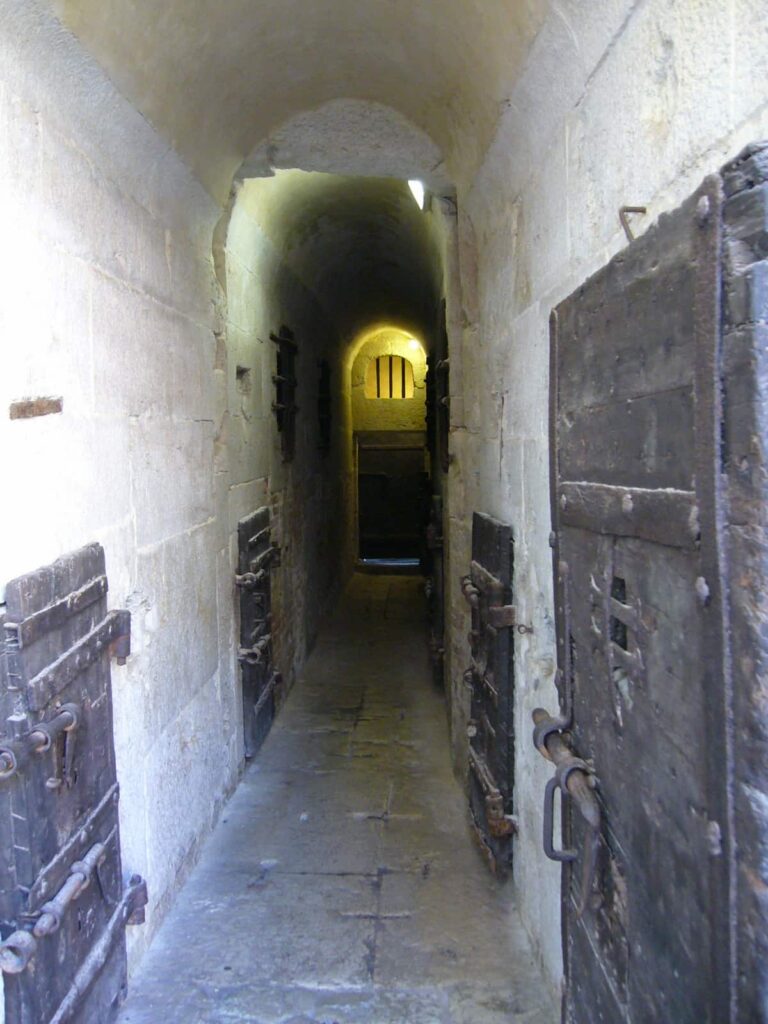
Passing through a series of narrow passageways, one arrives at the upper dungeons , known as the Piombi (the name comes from the metal from which the roofing sheets placed over the larch boards of the attic are formed).
The Piombi were a group of six to seven cells in which the accused awaiting trial by the Council of Ten or the State Inquisitors were housed.
As with the Pozzi the structure was concentric, with a perimeter corridor and the cells placed in the center .
This time, however, the spaces were lit by artificial lights and also by natural light coming from the roof windows, placed perfectly in axis with those of the cells.
The Piombi inmates enjoyed certain privileges ; they could have food and items delivered from outside, and they could have a small amount of money with which they could ask the keepers for certain errands. A small infirmary was also present.
The most famous inmate housed in these cells was surely the libertine writer Giacomo Casanova , imprisoned for suspected espionage activities, who by drilling a hole in the ceiling with the help of an accomplice, reached the roof and managed , by passing through a dormer window, to reach the Square Atrium and escape after being mistaken for a lost visitor to the Palace. The heroic adventure was later recounted in his book “ The Story of my Escape ,” published in 1788.
Other famous people locked up those cells were Daniele Manin, Nicolò Tommaseo and Paolo Antonio Foscarini .
The New Prisons
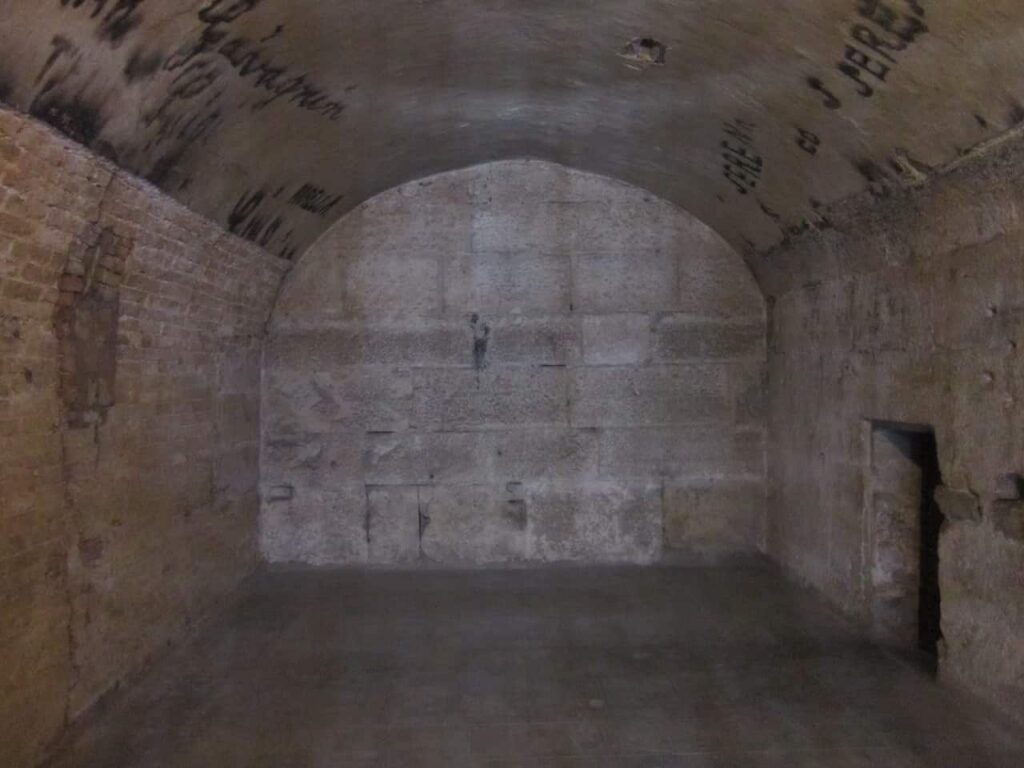
The prisons inside the Palace soon proved insufficient to accommodate the ever-increasing number of inmates , not to mention the poor conditions of the prisoners inside.
Overcrowding, the risk of fires from fires lit in an attempt to get warm, and the foul odors from the cells that now reached as far as the courtyard forced the Republic to find a solution by building New Prisons alongside the Palace .
The Prisons were accessible via the Bridge of Sighs , so after being tried inside the Doge’s Palace, inmates could reach the prisons directly without having to be led outside.
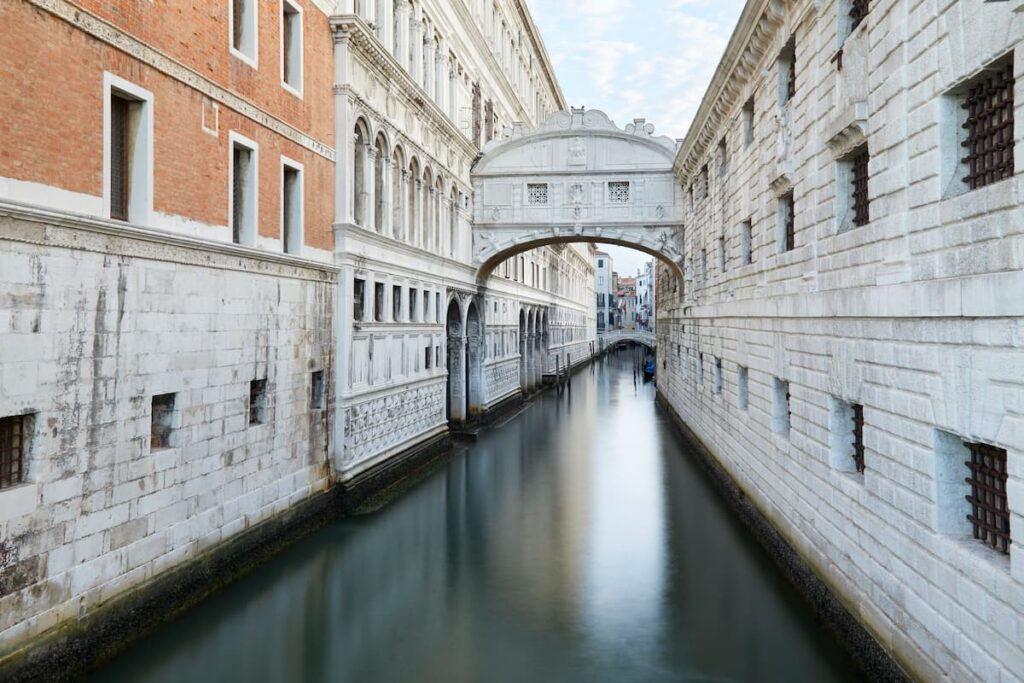
This was one of the first buildings in Europe created and designed to be a place of detention, designed by Antonio Rusconi in 1563 and completed by Antonio da Ponte .
The spacious building with massive and severe appearances was meant to provide the prisoners with healthier spaces with natural lighting and ventilation. It could hold up to 400 inmates .
The new two-story building is completely insulated on all four sides and features a large inner courtyard. Every window is equipped with strong bars to prevent inmates from escaping.
The main facade on the Schiavoni shore consists in the basement strip of a seven-arched Istrian stone portico of giant order with square pillars. The second floor has tall, slender openings with arched, triangular gables interspersed with Doric half-columns, in axis with the arches below.
The plan is crowned at the top by a corbelled cornice .
The façade placed in front of the Ducal Palace, on the Rio di Palazzo, has three orders of small, square openings; the vanishing lines of the bands of the ashlar walls in Istrian stone emphasize the perspective toward the Canonica’s Bridge .
Inside, along with the holding cells, was the room of the Magistracy of the Lords of the Night at Criminal . This body consisted of six members, one from each neighborhood of Venice, with the task of overseeing and instituting trials.
Their name was derived from the initial task of overseeing everything that happened in the city during the night. Members also met inside the torture room of the Doge’s Palace to attend interrogations.
The New Prisons would remain in operation until 1919 , surviving the Republic of Venice, the French and Austrian dominations, and to some extent the Kingdom of Italy.
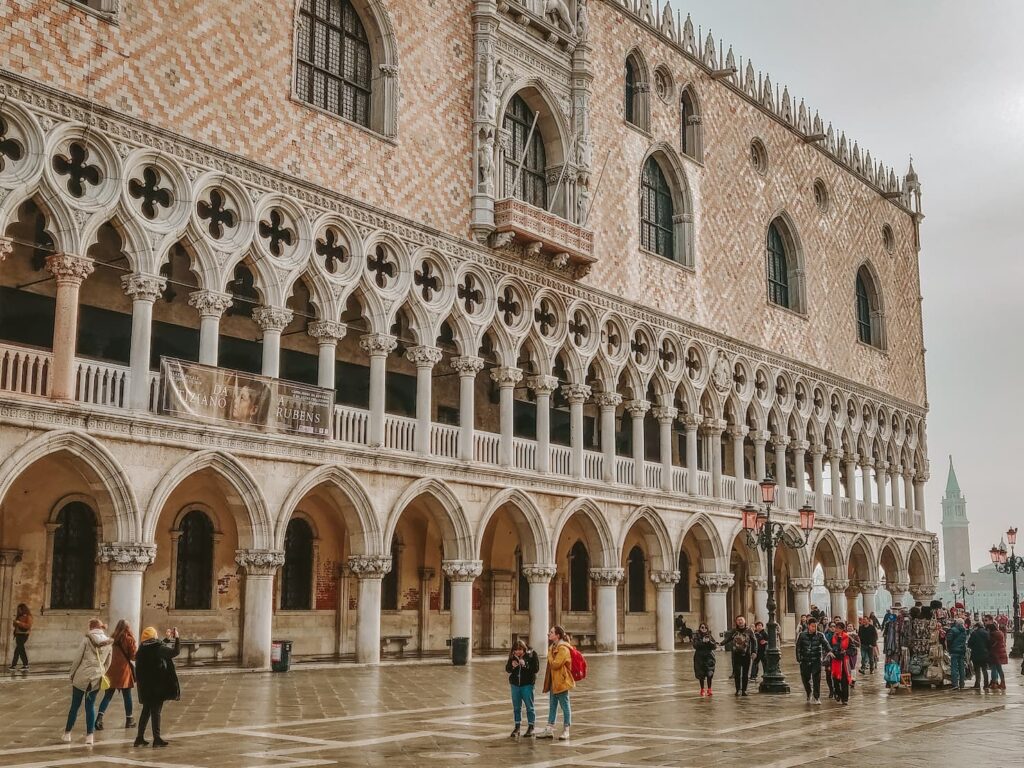
Frequently asked questions
How to see the prisons in venice.
You can visit the prisons of the Doge’s Palace in Venice by purchasing “ Secret Itineraries of the Doge’s Palace ” tickets.
The visit begins with a small staircase downhill that leads from the Hall of the Magistrate of Laws into one of the two narrow corridors of the Bridge of Sighs. The tour will take you to the rooms where, in the centuries of the Venetian Republic, activities related to the administration of the state and the exercise of power and justice took place.
In which rooms was justice administered inside the Doge’s Palace of Venice?
Within the Palace justice was administered and all judicial, civil and criminal proceedings took place, the different magistracies were based in certain rooms of the Doge’s Palace, here is a list of the most important ones:
- Hall of the Inquisitors : this office, which arose in the year 1539, judged crimes that endangered the security of the Republic, illicit dealings with foreign emissaries, slander on the government and political faults. The ceiling of the room houses decorations by Tintoretto, evoking the principles that the judges had to respect when passing their sentences: The Faith, Justice, The Law and Concord, while in the center of the octagon is painted the return of the prodigal son, representing the purpose of the inquisitors’ deliberations.
- Hall of the Three Chiefs : In this hall sat the three presidents of the Council of Ten, who held office for a month and were tasked with hearing the accused by investigating the veracity of the facts, bringing the trials before the assembly, and informing the decemvirs and the Signoria on the most urgent measures. Inside the room are Giambattista Zelotti’s canvases, Virtue Liberates Time, Truth and Innocence from Evil and Envy, and Giambattista Ponchino’s monochrome canvases, Justice Overcomes Rebellion and Faith Prevails over Heresy. Finally, Paolo Veronese’s canvas Virtue Defeats Evil and Nemesis Triumphs over Sin.
- Hall of the Quarantia Civil Vecchia : The Quarantia was the highest appellate body of the Venetian state. It was originally a single body consisting of forty members with broad powers, political and legislative. Later the quarantie became three: Quarantia Criminal (for judgments in the area we would now call criminal), Quarantia Civil Vecchia (for civil cases on Venetian territory), Quarantia Civil Nuova (for civil cases on the mainland).
- Halls of the Quarantia Criminale and dei Cuoi : Older than the Quarantia Civile, the Quarantia Criminale held judicial power by ruling in an appellate capacity on criminal cases; it was governed by three heads who composed, together with the doge and his advisors, the Serenissima Signoria. The furnishings and decorations were completely removed after the fall of the Republic, except for the seventeenth-century wooden stalls.
- Hall of the Magistrate of Laws : Inside this hall the three conservators and enforcers of the laws and orders of the offices of St. Mark’s and Rialto carried out their duties; their task was to oversee compliance with the laws inherent in lawyering and arbitrate in cases between close relatives in testamentary cases. This was also where the College of Twenty Savi of the Body of Forty met, whose role it was to arbitrate in disputes involving sums of little importance. The walls are home to significant works of Flemish art, including the Hell signed by monogrammer J.S., Metsys’ Christ Mocked, and two signed triptychs by Hieronymus Bosch, formerly housed in the Hall of the Three Heads of the Council of Ten, the Triptych of the Hermit Saints and the Triptych of St. Julia.
- Hall of the Censors : this was where the two-member magistracy met, whose job was to oversee the fairness of voting, servants’ wages, betting, offenses committed by gondoliers, and offenses committed by glassmakers.
- Hall of the Avogadori di Comun : this magistracy supervised offenses concerning the commune’s property and adjudicated cases between the treasury and private individuals. It also had the power to oppose the deliberations of the Great Council, the Senato and the Council of Ten (whose meetings always had to be attended by at least one avogadore).
- Casket Hall: In this room the avogadors kept the register of all Venetian patrician families, the so-called “Gold Book”, in which conjugal unions and births were recorded, so as to oversee the regularity and legitimacy of the entry of young nobles into the Great Council. There was also a similar list called the ‘Silver Book’ for citizens called originals, a social class that enjoyed special privileges, such as those d trade with foreign countries and hold public administration positions.
- Hall of the Provveditori alla Milizia da Mar : this office was in charge of arming the galleys of the Venetian fleet and hired sailors. The trade guilds of Venice and the subject cities were required to provide a certain number of sailors, following the payment of a tax earmarked for this purpose.
- Lower Chancery Hall : this is where the college of notaries used to meet; today the hall is occupied by the bookshop.
- Hall of the Ducal Bull : this was the room where the bollador affixed the ducal bull of nihil obstat to all practices, giving them validity.
Prisons of the Doges’ Palace: conclusions
Here we are at the end of this article on the prisons of the ancient Venetian Republic , in which we discovered together what the Piombi and the Pozzi are, how prisoners were treated, where they were locked up, and how they, in some, escaped.
If you have any questions and would like further insights, please feel free to leave a comment below .
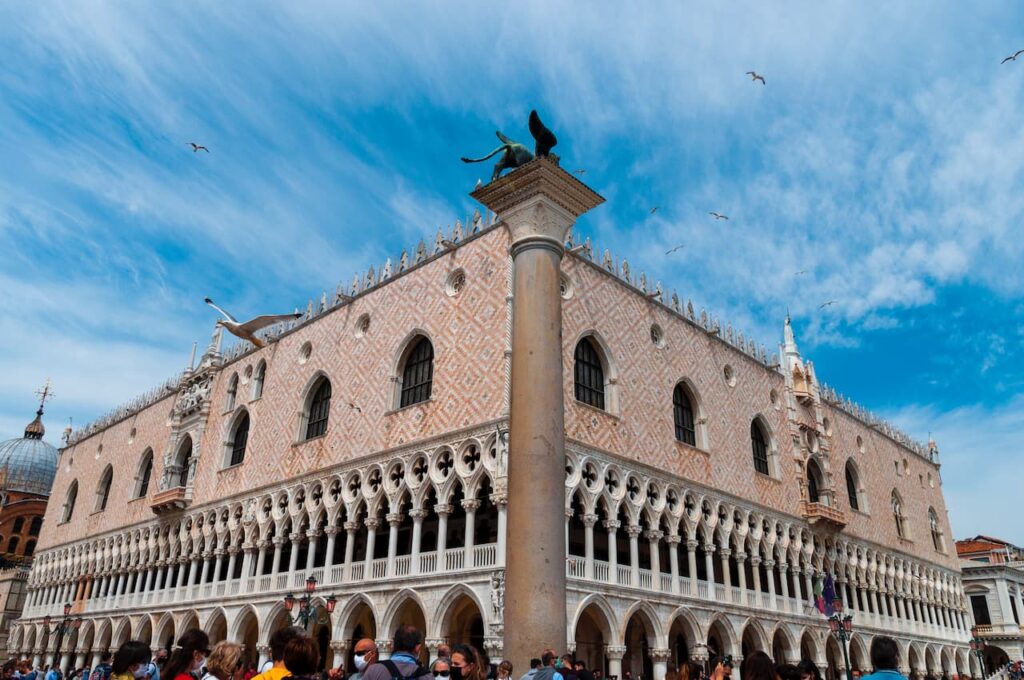
Photo credits:
- Cutaway of the prisons of the Doge’s Palace Venice: Photo via Wikimedia
- New Prisons of the Doge’s Palace Venice: Photo by Shay Tressa DeSimone via Flickr
- Piombi: Photo by di bart.lambert via Flickr
Related posts
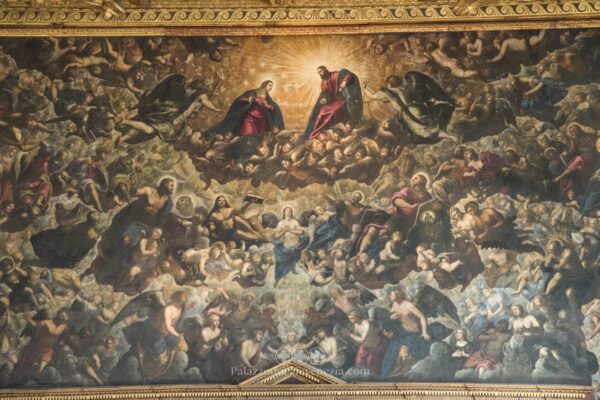
Tintoretto’s Paradise
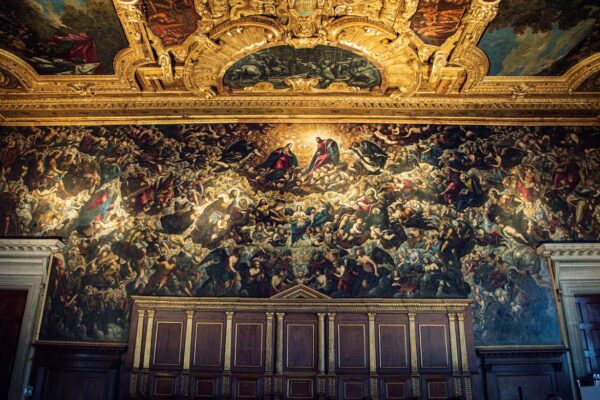
Doge’s Palace: Paintings and Works to See

Bridge of Sighs: History, Legends and Curiosities about the Bridge of Lovers
Leave a reply cancel reply.
Your email address will not be published. Required fields are marked *
Post Comment

Doge’s Palace, Venice (2024): How to Visit, Tickets, Tours & Tips (Palazzo Ducale)
By Author Jurga
Posted on Last updated: January 26, 2024
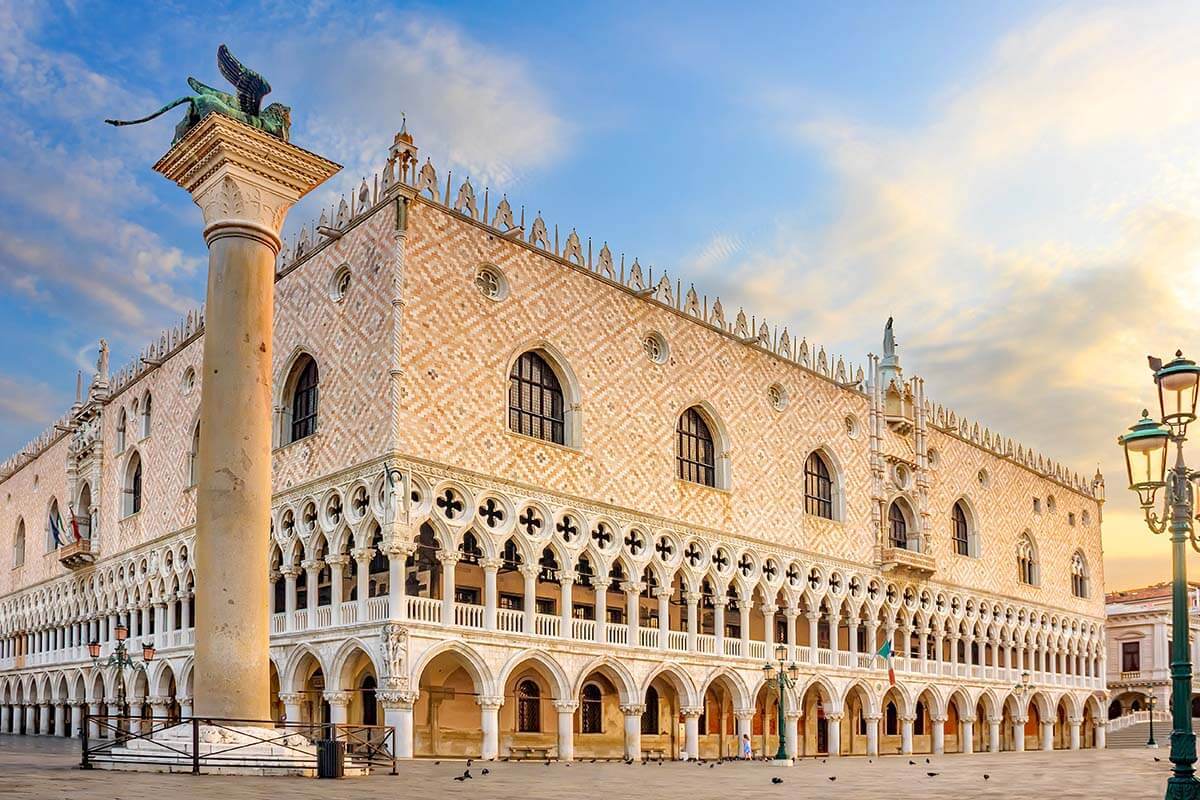
Thinking of visiting Doge’s Palace in Venice and wondering what to expect and if it’s worth it? In this guide, you can read all about it and learn our top tips for your first visit. Find out!
Doge’s Palace in Venice, Italy, ( Palazzo Ducale di Venezia ) is one of the main landmarks of the city . We have been to Venice many times and always admired the exterior of the stunning Gothic-style palace, but somehow never took the time to visit inside. We thought it was just another overhyped museum, but we couldn’t have been more wrong!
We finally visited Doge’s Palace on our recent trip to Venice and wow – the interior of the palace took our breath away! We also learned so much about the captivating history of the city that we never knew before.
If you are also wondering whether Doges Palace is worth seeing inside, what to expect, and how to make the most of your visit, this article should answer all your questions. We also include information about Doge’s Palace tickets and some of the best guided tours. Find out!
Best ticket & tour options for Doge’s Palace:
- Skip-the-line entrance ticket (same price as the official site and so much simpler to book).
- Guided tour .
- Exclusive after-hours tour of Doge’s Palace & St. Mark’s Basilica .

Why Visit Doge’s Palace
One of the top attractions in Venice and an integral part of the Venice waterfront, Doge’s Palace has a rich and fascinating history.
Visiting Doge’s Palace is key to understanding the city’s history. In addition, it’s well worth seeing its impressive architecture and lavish interior. It also gives you a unique opportunity to walk on the famous Bridge of Sighs.
For almost 1000 years it was the building from which 120 Doges (or chief magistrates) wielded their awesome power and decided Venice’s fate. This seat of government housed a Senate, court facilities, the secret police, and also prisons. It was also the residence of the Doge of Venice, who – once elected – would remain in his position for life.
By the end of the 13th century, Venice was one of Europe’s richest cities, mostly due to trading spices, silks, and wool between Europe and the Middle East. Its wealthy citizens became patrons of the arts, commissioning fabulous sculptures and paintings to decorate their palaces.
The building is an unmistakable testament to Venice’s wealth and power at the time! Its breathtaking facade – featuring gorgeous pink Verona marble – is a real Gothic masterpiece.
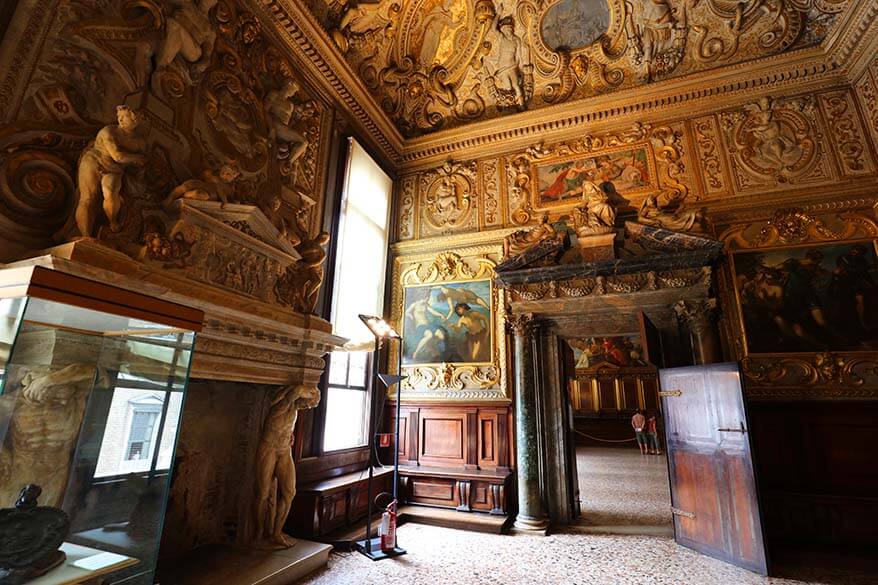
Inside you can see beautiful stone arches, magnificent sculptures, grand chambers, and historical artifacts. The museum also houses some of the most famous works of art in the world, including pieces by Titian, Veronese, and A. Vittoria.
Tintoretto’s masterpiece ‘Paradise’ – the largest oil painting in the world – hangs in the Hall of the Great Council.
Further below, you can find more information about the history of the Doge’s Palace, its most important features, and the main things not to miss on your visit. But first – some practical information and tips for your visit.
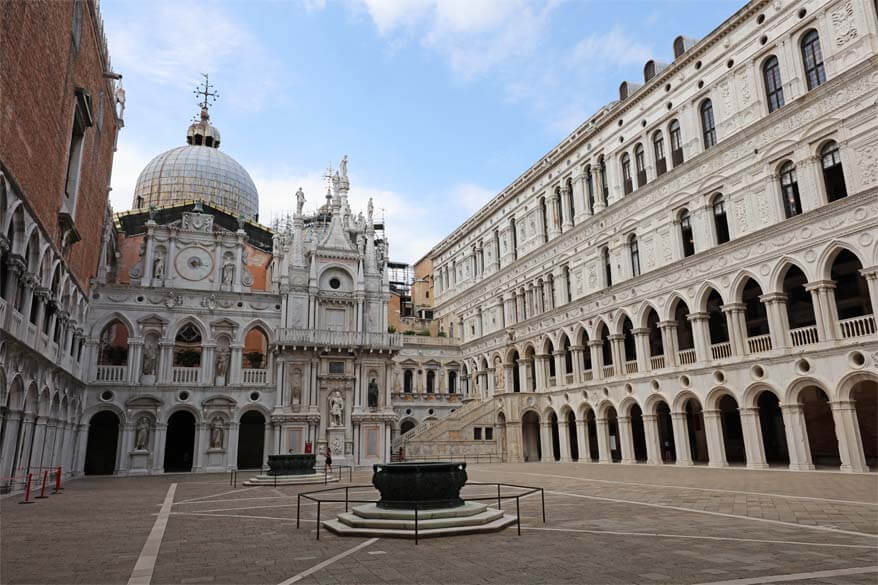
Location & Getting There
The Doge’s Palace is located on the famous St. Mark’s Square and right next to St. Mark’s Basilica. Since most of Venice’s must-see attractions are also located here, you don’t need to make any special effort to get to Doge’s Palace – it’s the main area of the city that everybody visits.
The entrance to the Palace is located on the wide waterfront promenade Riva degli Schiavoni. Nowadays, you enter the Palace through the Grain Gateway (Porta del Frumento).
You can reach Doge’s Palace on foot or by boat. If you are visiting Venice by car or by train and are walking from the Piazzale Roma area, simply follow the signs for ‘San Marco’. Count about 30-45 minutes of walking time without any stops.
A faster way to get there is by taking a public waterbus Vaporetto . Many lines stop at San Marco and you can easily get here from any part of town. Alternatively, you can also opt for a water taxi, which is by far the most luxurious and the most convenient way to travel around Venice (but also very expensive).
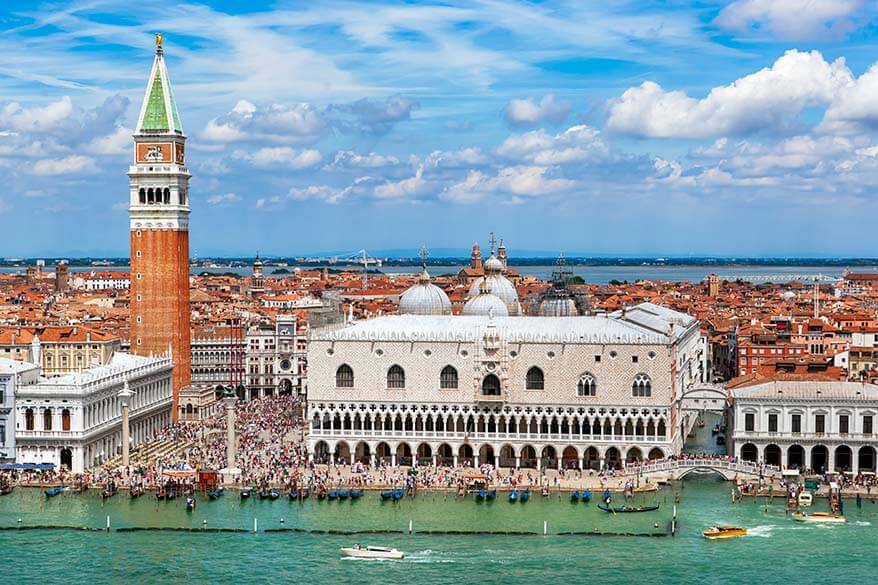
Opening Hours & Tickets
Doge’s Palace is open daily, in the high season from 9 AM to 7 PM (the last admission is an hour before the closing time). In the lower season, it closes at 5-6 PM.
At the moment of the last update, tickets to Palazzo Ducale cost around 30-33 EUR. There are discounts for kids, students, and senior citizens.
You can buy tickets online on the official website (see below), but the whole interface looks quite complicated. We bought our tickets on GetYourGuide . You can reserve timed-entry fast-track tickets on Tiqets as well. Both these sites have the same price as the museum itself (but these websites are so much easier to use!).
Good to know: All Doge’s Palace tickets also include the Correr Museum, National Archeological Museum, and Biblioteca Marciana.
For up-to-date practical information, please check the official website of the museum .
TIP: If you are planning to visit Doge’s Palace and St. Mark’s Basilica, consider this digital Venice Pass . It allows you to prebook timed entry tickets and also includes a gondola ride or the islands tour – a very good value.
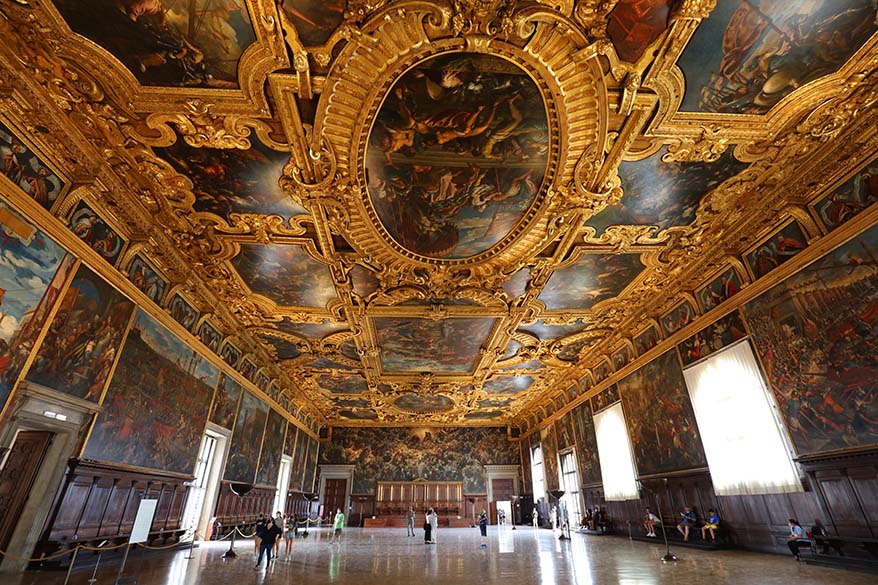
How to Visit & Tours
You can get your tickets in advance, there are informational panels inside, and so it’s very easy to visit Doge’s Palace on your own. However, it only looks simple on paper!
Together with St. Mark’s Basilica, Doge’s Palace is one of the most popular tourist attractions in the city. No matter when you come, it will always be busy here. So if you want to make the most of your visit, it’s essential to plan in advance!
If you decide to visit on your own , it’s best to go here early in the morning or an hour or two before closing time. Make sure to get skip-the-line tickets in advance . We were in Venice on an extremely quiet day when there were almost no foreign tourists in town. Still, we had to wait over 45 minutes in line at Doge’s Palace. On a busy day, queues can take up to several hours. However, there’s a separate entrance for those with skip-the-line tickets. It’s absolutely worth it!
The best way to visit Doge’s Palace is by taking a guided tour . Not only do you get priority access, but going with a local guide also allows you to better appreciate everything you see. Furthermore, it’s often so busy inside that you don’t even know where to go first and you might easily skip some of the main sights without even realizing it.
So if you want to see as much as possible in a short time and also learn more about the history of Venice and the Doge’s Palace, then definitely consider going with a guide. Here you can book a guided tour for Doge’s Palace only . But I recommend going on a tour that also includes St. Mark’s Basilica . It’s the best use of your time and money!
INSIDER TIP: If you are looking for an unforgettable experience in Venice, take a look at this exclusive after-hours guided tour . It brings you to Doge’s Palace and St. Mark’s Basilica in the evening, after it closes to the general public. It’s magical!

How Much Time Do You Need
You need at least 1-1.5 hours for a quick visit to Doge’s Palace. This does not include queuing times. If you want to explore it deeper you will need 2-3 hours.
TIP: Going with a guided tour, you can usually visit both – Doge’s Palace and St. Mark’s Basilica – in just 2-2.5 hours. You’d never be able to see that much in such a short time on your own. If your time in Venice is limited, this is by far the best option. Here you can see availability and book the best-rated skip-the-line tour for these two main Venice attractions.
READ ALSO: How to See the Best of Venice in One Day

Doge’s Palace with Kids
If you are wondering whether it’s a good idea to visit Doge’s Palace with kids, I’d say go ahead. There is enough variation in what you see that even younger kids shouldn’t get bored.
Our boys were truly impressed by the sheer size of the Palace, the huge painted halls, and the armory exhibits. They also enjoyed visiting the prison cells and walking over the Bridge of Sighs. If you tell your kids some history of the place and give some explanation of what you see, they’ll enjoy the visit more.
That being said, all three of our kids (age 9-12) were quite tired after a visit here. So younger children will probably find a visit here quite tiring as well. There are lots of stairs and walking slowly can be more tiring than hours of hiking outdoors. So if you are visiting Venice with a baby or a toddler , Doge’s Palace might not be the best place to take them.
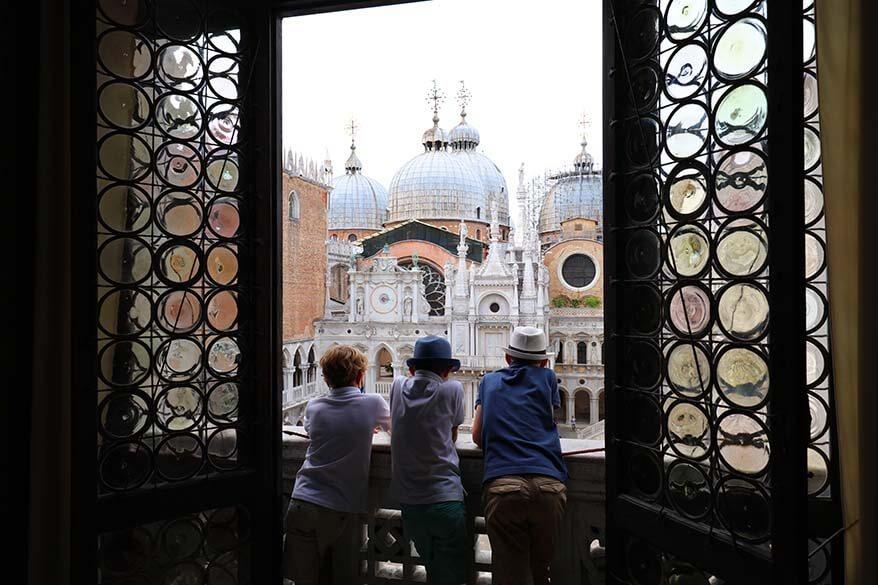
Is Doge’s Palace Worth It?
Yes, Doge’s Palace is absolutely worth a visit, even if you only have a day in Venice. Not only is it the best place to learn more about the fascinating history of Venice, but its splendid interiors will take your breath away. It’s also your chance to walk on the iconic Bridge of Sighs!
Knowing that very few citizens of Venice were ever allowed to enter this building, a visit here feels even more special.
What left the biggest impression on us was the contrast between the opulence of the luxurious residential apartments and lavish council chambers and the grim desperate conditions of its prisons. It’s an eye-opening experience that will help you to better appreciate what a fascinating city Venice really is.
Below, you can read more about the history of Doge’s Palace and find a short list of the main points of interest to see inside. Take a look!

The Doge’s Palace – with its strategic location at the point of access to the sea – was built around the 9th century as a fort. Originally with a tower at each corner, the building has seen many changes over the years. This is reflected in the mixture of architectural styles from several periods.
In the 12th century, Doge Sebastiano Ziani transformed the fort into a palace. It was gradually expanded throughout the 13th and 14th centuries.
Unfortunately, a number of destructive fires did enormous damage to the building in the 16th century. However, because of this, the palace was restructured and improved. Some of its most beautiful additions, such as the Stairs of the Giants , were made at that time.
The original building already housed prisons – known as ‘ Piombi ‘. In the 17th century, new prisons were built to supplement them. The Bridge of Sighs connecting the new prisons to the palace across the canal also dates from this time.
In the 18th century, the Palace was slightly remodeled to house administrative offices and it was still used as a prison. After 1866, when Venice was annexed to Italy, Doge’s Palace was restructured several times. It finally became a museum in 1923.

Things to See Inside
There is so much to see inside the Doges Palace! If you follow the indicated route, you’ll pass all the main sights. However, it can get so overwhelming that it’s easy not to notice some of the nicest features. So here are the main points of interest that you shouldn’t miss when visiting Doge’s Palace:
Courtyard & Staircase of the Giants
The impressive courtyard is the first place you see when you enter the Palace. The highlight of the courtyard has to be the Staircase of the Giants ( Scala dei Giganti ), at the top of which the doge’s coronation would take place.
In the 15th century, the Great Council came up with an idea for creating a ceremonial staircase. The Giants Staircase takes its name from the two enormous statues of Mars and Neptune that symbolize Venice’s power by both land and sea.
To the right of the Giant’s Staircase is the Senator’s Courtyard . This is where the members of the senate would gather before government meetings. In the middle of the courtyard, you can see two well-heads dating from the middle of the 16th century.
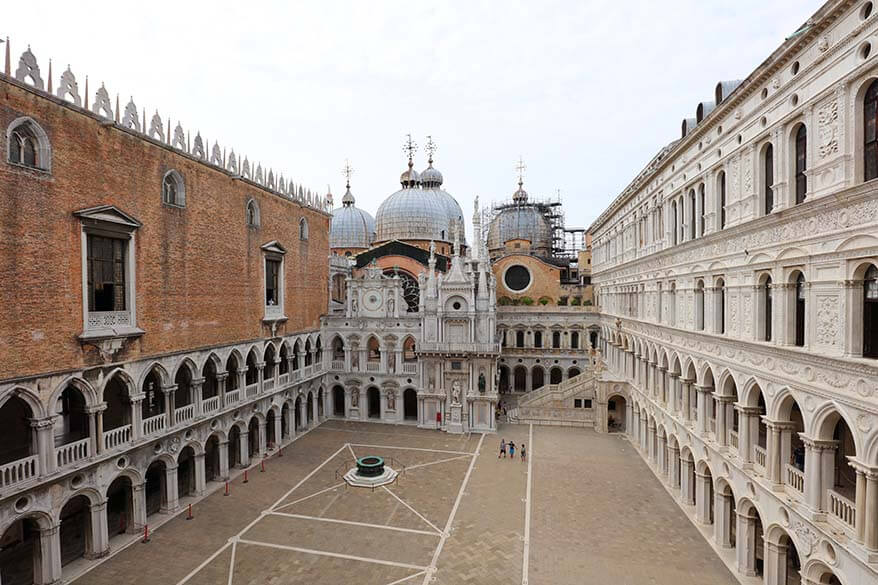
Golden Staircase
Golden Staircase ( La Scala d’Oro ) is a very impressive ceremonial staircase leading up to Doge’s apartments and to the chambers of the state government.
The staircase was completed in 1559 and is indeed decorated with real 24-carat gold.
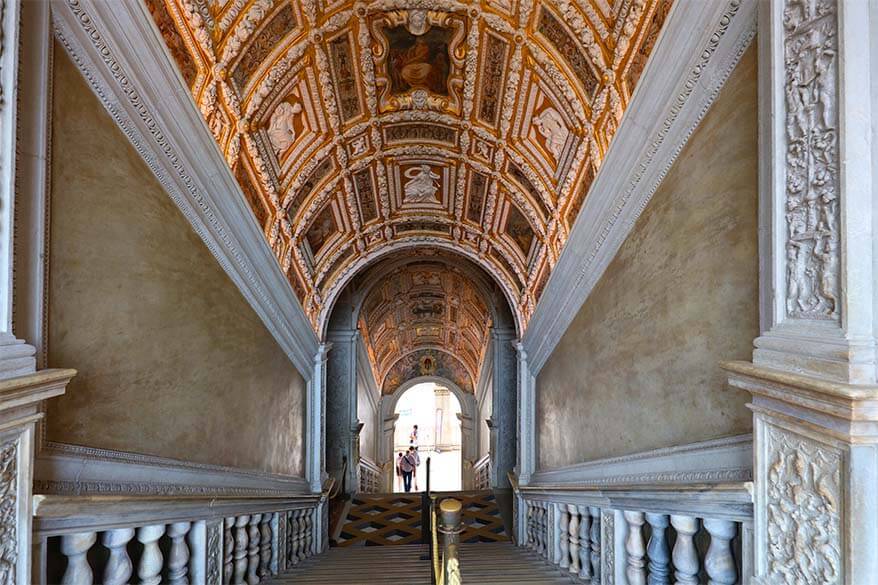
Doges’ Apartments
The Doges’ Apartments on the second floor are very impressive but quite modest in size (especially when you consider the power of the various doges that occupied them). This was probably a deliberate reminder that although the doge was a state symbol, he was – more importantly – its first servant.
The original rooms were destroyed by fire in 1483 and the apartments were rebuilt in Renaissance style. They were individually furnished by each incoming doge, using items from his previous home. On his death, his furnishings would be removed to make way for his successor.
Today they still house some incredible artwork, including the 16th-century fireplace and the carved ceiling of the Sala degli Scarlatti .
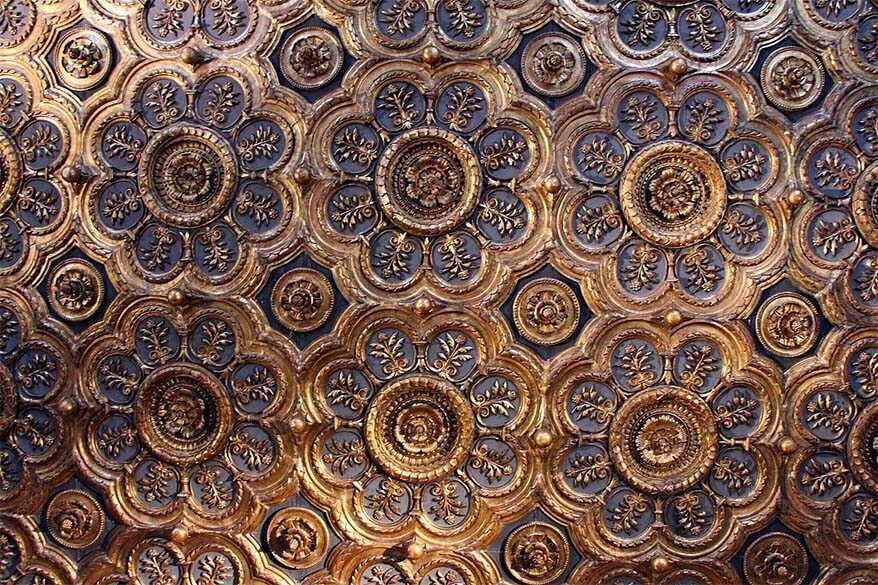
Senate Hall
Senate Hall ( Sala del Senat o) is an imposing and lavishly decorated Hall. It was used for various governmental functions, including the appointment of new ambassadors and the making of important decisions on foreign policy.
Venice’s Senate was founded in the 13th century and was one of the city’s oldest public institutions. It was made up of members chosen from the city’s wealthiest families. Its areas of responsibility included financial and political affairs, trade, and manufacturing.
In 1574, a fire damaged much of the Hall and it was refurbished in the 1580s. Its ceiling was beautifully decorated with Tintoretto’s ‘ Triumph of Venice ‘, whilst the main focus of the Hall became another of Tintoretto’s works, ‘ Christ ‘.
This painting was likely commissioned in acknowledgment of the Senate’s ‘conclave’. Responsible for electing the doge, the conclave was seen as being protected by the Son of God. Under the painting, you will see the ornamental seat in which the doge would sit during meetings.
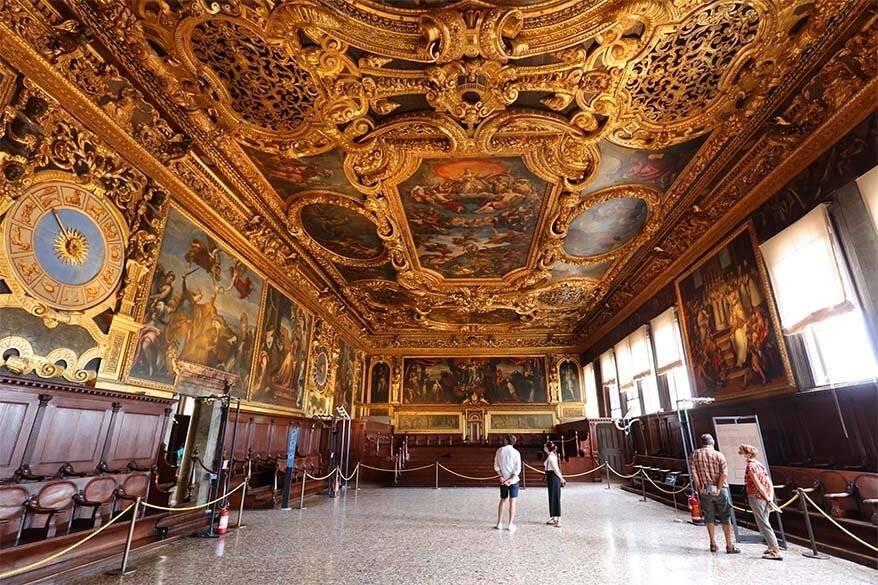
Chamber of the Great Council
The Great Council Hall ( Sala del Maggior Consiglio ) is an even bigger hall with stunning paintings on all walls and ceilings. The Great Council, the most important political body in the Republic of Venice, held its meetings here.
This room is huge and measures 53 meters in length and 25 meters in width. It was one of the largest halls in Europe and could fit up to 2000 people. It was clearly built and decorated to show power and wealth and to impress whoever visited here. Its lavish decorations and beautiful paintings reminded me of the Painted Hall in London .
There are 35 painted panels on the ceiling. The most famous of them all is the Apotheosis of Venice , a painting by Paolo Veronese, dating from 1585. Just under the ceiling, you can see portraits of the first 76 doges of Venice . The portraits of the later doges can be found in the Sala dello Scrutinio.
Tintoretto’s painting ‘Il Paradiso’ – the world’s largest oil painting on canvas – can also be found in this room.
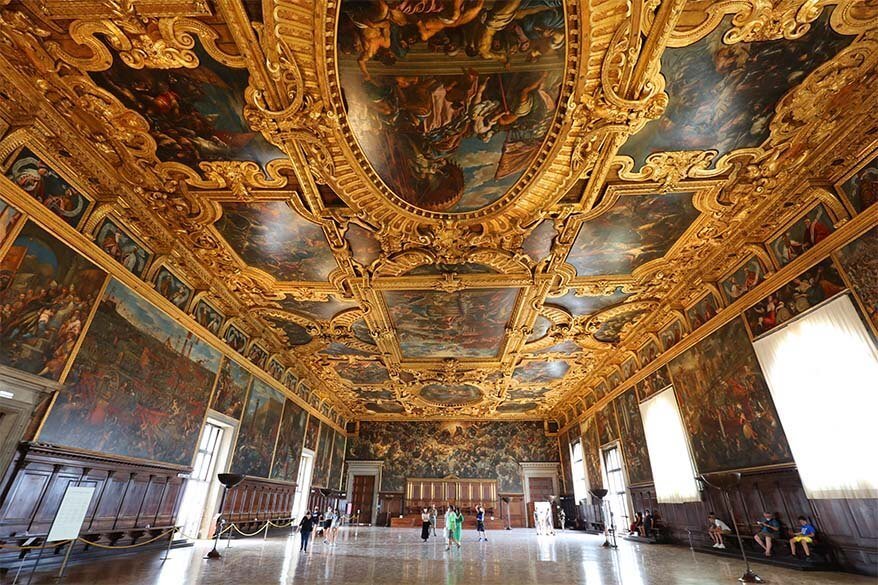
Bridge of Sighs
One of the most famous bridges in the world, the Bridge of Sighs ( Ponte dei Sospiri ) was designed by Antonio Contino. It was built in 1600 in order to connect the interrogation rooms and courts of the Palace to the new prisons on the other side of the canal. This is the route that convicted prisoners would have taken to their cells after sentencing.
Lord Byron mentioned the bridge in 1812 in his book ‘Childe Harold’s Pilgrimage’, saying “ I stood in Venice, on the Bridge of Sighs; A palace and a prison on each hand .” It is this reference that likely led to the bridge’s fame.
The Bridge of Sighs got its name in around the 18th century. It refers to the sighs of the prisoners who took a last glimpse of the outside world through the tiny openings of this enclosed bridge on their way to the prison cells.
In reality, looking across Venice from this enclosed bridge is actually quite difficult. There are just a few small openings from which you can get a glimpse of the hustle and bustle of the canal below.
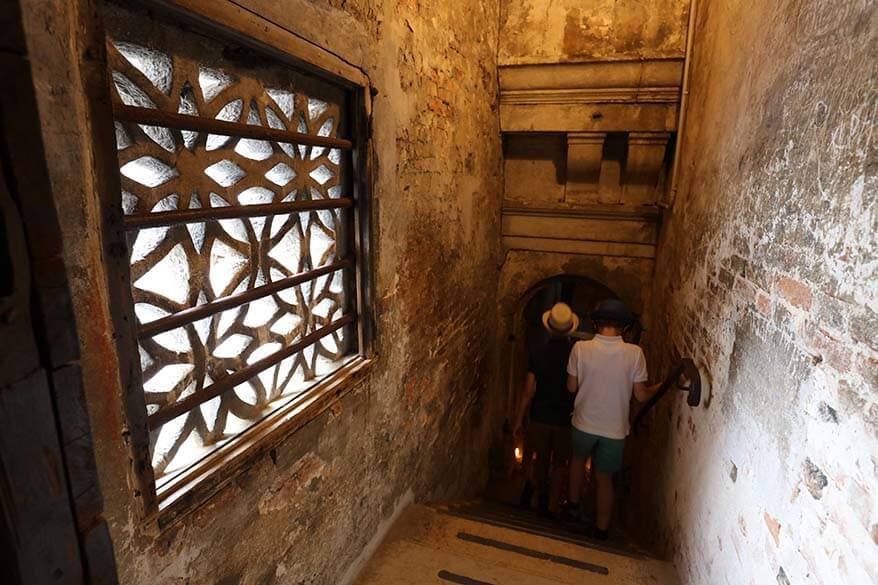
Interesting to know: The interior of the enclosed bridge is divided into two separate corridors. That way, prisoners walking in one direction wouldn’t meet anyone coming from the other side. When you are visiting Doges Palace, you’ll walk over the bridge twice without even realizing that there is another side of it.
Despite its grim history, the bridge – made of white limestone – is quite beautiful. Happily, it has now become a symbol of romance. According to a popular legend, couples sailing beneath it on a gondola – kissing as they pass – will experience eternal love.
TIP: You can also see the Bridge of Sighs from the bridge at Riva degli Schiavoni and also from the other side. And indeed, if you take a gondola ride in St. Mark’s area, you can pass under the bridge in a gondola.
READ ALSO: Tips for a Gondola Ride in Venice

Prison Cells
The cold dark prison cells form a sharp contrast with the luxurious chambers of the Doge’s Palace. It’s almost hard to believe that this is the same building!
Dating back to the 12th century, the prison cells of Doge’s Palace are composed of the Piombi, the Pozzi, and the Prigioni Nuove (New Prisons). Conditions in the prisons were truly terrible, and few of those who entered them would ever see the light of day again.
It was very easy to end up in prison in Venice at that time! The Palace was surrounded by mailboxes shaped like lions’ mouths, into which citizens could post pieces of paper bearing the names of neighbors they suspected of wrongdoing. All accusations were thoroughly investigated and tried by the dreaded Council of Ten, one of the main governing bodies throughout the 14th – 18th centuries. Those who were convicted were sent to the cells within the Palace walls.
In English, the Piombi is known as the ‘Leads’, because the cells were located directly under the lead-covered roof. This made them unbearably hot in summer and bitterly cold in winter. As bad as they were, they were still better than the ‘Pozzi’ on the ground floor. These cells were damp, tiny, and barely lit, with just a bucket for excrement. The conditions in the New Prisons were somewhat better, though still incredibly harsh.
Though notoriously difficult to escape, one famous prisoner managed to do so. That was Casanova, who escaped the prison in 1756.
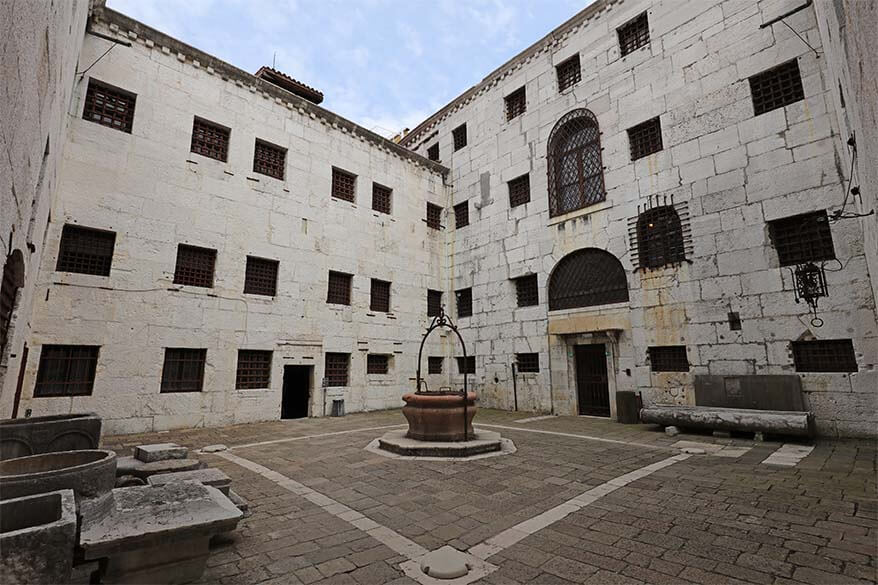
The Paper Gate ( Porta della Carta ) was originally the main entrance to the Palace and links the Palace to St Mark’s Basilica. Nowadays, you leave the Palace via this gate. It’s most impressive when viewed from St. Mark’s Palace, so make sure to look back as you are leaving!
TIP: Even if you are not visiting inside the Doge’s Palace, you can still see this gate. You can find it on the right side of St. Mark’s Basilica; where it connects to the Doge’s Palace.
The origin of its name is not clear. Some say it is the ‘Paper Gate’ because it is near the area in which the scribes would put up their desks, or where people waited to hand their petitions to council members. Others believe that its name came from the ‘cartabum’ – the archive of state documents that is located nearby.
Considered to be one of the finest examples of Venetian Gothic architecture, the 15th-century Paper Gate features ornate carved figures. Its most remarkable feature is the sculpture of Doge Francesco Foscari kneeling in front of the lion of Saint Mark . This sculpture is actually a 19th-century copy of the original, which was destroyed in 1797 when Venice was invaded by Napoleon’s army. The sculpture is said to be symbolic of the fact that even the mighty doge must bow before the power of the state.
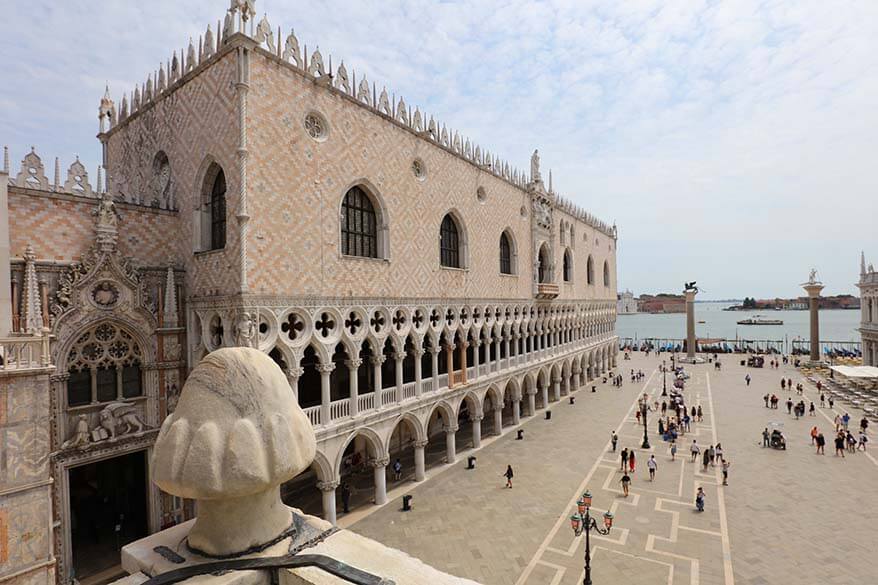
So, this is our guide to visiting the famous Doge’s Palace in Venice. If you plan well and get your tickets (or book a tour ) in advance, a visit here only takes an hour or two of your time. So don’t miss it! This is truly one of the must-see places in Venice.
If you are visiting Venice soon and are wondering how to plan your time, take a look at these suggested itineraries:
- 1 Day in Venice
- 3 Days in Venice (it will also work for 2 days – just pick the sights that interest you the most).
READ ALSO: What to See & Do in Venice (all the top sights and attractions that you shouldn’t miss)
Some travel guides and inspiration for Italy:
- Best Places to See in Italy
- Best Italian Cities to Visit
- Rome 1 day itinerary
- Milan 1 day itinerary
- Naples 1 day itinerary
- Florence 1 day itinerary
- Rome 2 days itinerary
- Rome 4 days itinerary
- Best towns in Tuscany
- What to see and do in Rome
- What to see and do in Florence
- What to see and do in Milan
- What to see in Siena
- What to see in Verona
- What to see in Ravenna
- What to see in Naples
- For more tips and inspiration for a variety of popular destinations in Italy, take a look at our Italy travel guide .
If you found this post helpful, don’t forget to bookmark it and share it with your friends. Are you on Pinterest? Pin these images!

This site uses Akismet to reduce spam. Learn how your comment data is processed .
Sunday 11th of June 2023
Thank you for this! All your information was very helpful!! I was trying to book tickets on their website & found it very confusing as you mentioned too! I wasn’t quite sure what I was buying even though I had selected “ English”. I used one of the links you listed to grab the tickets ahead with it being the same price! Love, love all the info about Doge’s Palace that you wrote! Very helpful & relevant ( even the fact that Doges palace means Palazzo Ducale!)
Monday 12th of June 2023
Thank you for your kind feedback, Sabrina. Appreciate it. And yes, it's often so much easier to get tickets via Tiqets or GetYourGuide than direct. We get all our tickets/tours via these companies nowadays and it makes any trip planning much simpler. Enjoy your trip!
Sunday 30th of April 2023
Is it possible to visit the courtyard without purchasing tickets to go inside the apartments and museums?
Hi Tanya, the entrance and the security check are located before you enter the courtyard, so no, you cannot see it without a ticket.
Doge's Palace Secret Itineraries Tour in Venice
Visiting the Secret Rooms of the Doge's Palace
TripSavvy / Christopher Larson
Visitors to the Doge's Palace , one of Venice's top attractions, can also book a tour of the Itinerari Segreti . The Secret Itineraries Tour takes you to parts of the palace that are off limits during the regular visit, including secret passageways, prisons, the torture chamber, an interrogation room, and the infamous Bridge of Sighs.
Note that the Secret Itineraries tour is available only by reservation (see below) and is not part of the general admission ticket. If it's something you don't want to miss on your trip to Venice—and we do highly recommend it—be sure to book your tour well in advance of your visit.
How to Book the Doge's Palace Secret Itineraries Tour
The Secret Itineraries Tour is a guided tour and is available only with a reservation. English language guided tours are currently available several times daily. Book the Secret Itineraries English language guided tour through the Doge's Palace website. The guided tour ticket also includes general admission to the Doge's Palace so you can visit at your leisure after the tour.
Highlights of the Secret Itineraries Tour:
- The Ducal Notary, the Deputato allo Segreta, the Office of the Great Chancellor, and the Chamber of the Secret Chancellery - All of these administrative rooms held the most important documents of the Venetian Republic. The first two offices, which were interconnected, were occupied by the Doge's notary and an archive for the Council of Ten, the Secret Service of the Republic of Venice. The Great Chancellor was the only figurehead to be elected by the Maggior Consiglio and his job was to oversee the State Archives. Other important and secretive documents were held in the cabinets that lined the walls of the Secret Chancellery.
- The Torture Chamber and the Piombi - The haunting Torture Chamber is set up with some of the devices used on Venetian prisoners. The Piombi are the lead-lined prison cells where prisoners who had been caught by the Council of Ten were held. These included mostly political prisoners and also Giacomo Casanova, who famously escaped the Piombi in 1756 and wrote about it in his memoirs.
- The Attic - The attic is one of the older parts of the Doge's Palace and is where a tower once stood. The room contains a Doge's coat of arms and a cache of 16th-century weapons.
- The Inquisitors' Chamber - A flight of stairs leads from the Attic to the Sala dei Inquisitori alla Propagazione dei Segreti dello Stato, where three magistrates from the highest ranks of Venetian government met to discuss and protect state secrets. The ceiling in this shady room contains beautiful paintings by Tintoretto.
- The Bridge of Sighs - The Secret Itineraries Tour typically ends at the Bridge of Sighs . Visitors can walk through the narrow, cramped corridors of the footbridge and see Venice as prisoners of yore once saw it: through narrow grills on the windows.
For more tips on how to see the best of Venice and get the most from your stay there, see our guide: Visiting Venice: Italy's Most Romantic City .
Experience the Gothic Past of Venice at the Doge's Palace
The Top 10 Things to Do with Kids in Venice
Doge's Palace in Venice: The Complete Guide
Venice, Italy Guide: Planning Your Trip
The Best Things to Do in Venice, Italy
The Bridge of Sighs: The Complete Guide
What to See at the Doge's Palace in Venice
10 Unique Guided Tours in Rome
Regensburg: Planning Your Trip
Vatican City Travel Guide
Top Museums in Venice
20 Best Things to Do in Florence, Italy
Florence and Venice Sites Found in Dan Brown's Inferno
The 25 Top Attractions in Rome, Italy
Saint Mark's Square in Venice
12 Amazing Castles to Visit in the Czech Republic
Venice Private Tours
Venice food tours, st. mark’s basilica, murano & burano, gondola tours, doge’s palace, st. peter’s basilica, st. peter's dome, sistine chapel, private tours, the grand canyon, pompeii from rome, cooking classes, raphael rooms, paris food tours, eiffel tower, statue of liberty, nyc food tours, metropolitan museum (met), central park, last supper, lake como from milan, windsor castle, westminster abbey, tower of london, harry potter, changing of the guard, vegas shows, uffizi gallery, tuscan wine tours, statue of david, florence food tours, florence duomo, accademia gallery, colosseum underground, sagrada familia, montserrat from barcelona, casa batllo, barcelona food tours, barcelona boat tours, athens food tours, rijksmuseum tours, amsterdam food tours, amalfi coast, water & boat tours, sorrento boat tours, capri boat tours, the best doge's palace tours, book tours of the iconic royal palace and venetian prison.
Explore the Doge’s Palace in-depth with one of our skip the line tours. See inside the Bridge of Sighs and learn about the darker side of its history when your English-speaking guide shows you the prisons. If you can’t wait to go behind the scenes, join our Doge’s Palace Venice Tour.
The Doge’s Palace, or Palazzo Ducale, is the building from which the most important magistrates once ruled Venice. It is also where they tortured their enemies! The building is a grand example of Venetian Gothic architecture and the interior features lavish decor and art by masters like Titian. All of which was created to cover up the darker side of Venice. It’s not just an incredible palace, it is also linked to prison by the famous Bridge of Sighs. Explore the Doge’s Palace in-depth with one of our skip the line tours. See inside the Bridge of Sighs and learn about the darker side of its history when your English-speaking guide shows you the prisons. If you can’t wait to go behind the scenes, join our Doge’s Palace Venice Tour.
Filter by the price per person
4 results found

Skip the Line
St. Mark’s Basilica & Doge’s Palace Half-Day Tour with Gondola Ride
Explore St. Mark's Square's most iconic attractions with skip-the-line tickets and an expert guide
( 317 ) as low as $100.32

Venice in a Day Tour with Gondola Ride
Visit St. Mark's Basilica, Doge's Palace, Rialto Bridge, and the hidden areas of Venice
( 190 ) as low as $129.62

Ultimate Venice in a Day with Murano and Burano
Do more in a day: St. Mark's, Doge's Palace, glassblowing and lacemaking demos, and a gondola ride
( 195 ) From: $163.23

Venice Doge's Palace Private Tour
Dive into Venice's dark history at its grand Gothic palace, Bridge of Sighs, and ancient dungeons
( 9 ) From: $378.50
Europe is re-opening for visitors!
Want to see which small group tours are now operating ?
More tours added weekly!
See Open Tours

- Travel Blog
- In The Press
- Help Center
- Top Attractions
Policy & Terms
- Cancellation Policy
- Terms & Conditions
- Privacy Policy
- USA or Canada: +1 888 290 5595
- Email: [email protected]

© 2024 - The Tour Guy All rights reserved.
Palazzo Ducale
Doge's palace.
Doge's Palace A masterpiece of Gothic architecture, is the very symbol of Venice
Museo Correr
Museo Correr The Royal Palace, the neoclassical rooms and Antonio Canova, the History of Venice and the Picture-gallery
Ca' Rezzonico
Ca' Rezzonico Among precious historical furnishings, it houses important works of the XVIII century Venice
Ca' Pesaro The International Gallery of Modern art houses masterpieces such as works by Medardo Rosso, Rodin, Kandinsky, Klee...
Glass Museum
Glass Museum Housed in Murano, the museum hosts the most extensive historical collection of Murano glasses
Natural History Museum
Natural History Museum An evocative and engaging layout for discover the secrets of nature and living beings
Mocenigo Palace
Mocenigo Palace Museum of Textiles and Costumes with the itineraries dedicated to perfume
Fortuny Museum
Fortuny Museum Visit the gothic Palazzo Pesaro degli Orfei, transformed by Mariano Fortuny into his private studio
Lace Museum
Lace Museum Housed in Burano, the museum exhibits rare and valuable specimens of Venetian lace, from the 16th to the 20th century
Carlo Goldoni's house
Carlo Goldoni's house The house where Carlo Goldoni was born contains a small museum and a library of theatrical studies
Clock Tower
Clock Tower For over 500 years it has marked the life, the history and the continual passage of time of Venice
Visitmuve Visit the website of Civic Museums of Venice
- Building and history
Layout and collections
- Research Services
- Conservation projects
- Exhibitions
- Exhibitions Archive
- Current Events
- Events Archive
- MUVE Education
- Opening hours
- Services and Accessibility
- SPECIAL ITINERARIES
- How to get there
- Announcements
- 🎟️ Tickets
- The Museo dell’Opera
- The Courtyard and the Loggias
- The Doge’s Apartments
- First floor
- Second floor
- The Loggia floor
- The Chamber of the Quarantia Criminale
- The Cuoi Room
- The Chamber of the Magistrato alle Leggi
- Atrium of the Prisons
- SPECIAL ITINERARIES: Secret Itineraries Tour
SPECIAL ITINERARIES: The Doge’s Hidden Treasures
- Photographic Archive of the Musei Civici di Venezia
- Room of the Four Doors
- Google Arts & Culture
- MUVE APP Audioguide
New guided tour in the Doge’s Palace

Following the extensive conservative restoration work that has restored the original splendour of its interior, the evocative rooms of the Chiesetta and Antichiesetta del Doge are the fulcrum of a new, fascinating artistic-historical tour to discover The Doge’s Hidden Treasures in the Doge’s Palace.
The new itinerary, which requires reservations and a qualified guide (see general information ) , is an addition to what is already an extraordinary cultural offer from Fondazione Musei Civici in Venice; it unfolds in the Doge’s private rooms in the wing of the Doge’s Palace adjacent to the Basilica.
This fascinating itinerary explores locations originally inaccessible to the public. The guided tour begins at Porta della Carta , the monumental 15th-century entranceway leading to the Terrazza Foscara , where visitors are met by nostalgic 19th-century sculptures that recall the ancient, mythical glories of Venice.
The tour continues to the Loggia Foscara , a Renaissance addition to the Gothic layout of the Palazzo Ducale. Inside, after passing through an antechamber set up as a defence area, visitors enter the heavily armoured Sala dei Forzieri , the ancient Treasure Chamber, where a selection of precious artefacts from the depositories of Venice’s civic museums have been returned to public display.
The tour then leads to the Doge’s Terrace , a panoramic vantage point for viewing the east, west and south wings of the Doge’s Palace. From there, the route passes briefly through the Doge’s Apartment , a series of rooms specially reserved for him.
At this point visitors climb a steep staircase, where behind, like a backdrop, hangs Titian’s monumental fresco from 1523, depicting a robust St. Christopher carrying the Child Jesus across the lagoon waters.
At the top, the tour arrives at the evocative Chiesetta del Doge (Doge’s Church), redesigned by the architect Vincenzo Scamozzi. The chiesetta houses a sumptuous altar with the 16th-century sculptural group Madonna con il Bambino e quattro angeli by Jacopo Sansovino and workshop, as well as allegorical frescoes from the mid-18th century by Jacopo Guarana and illusionistic painters Girolamo and Agostino Mengozzi Colonna, which enlarge the spaces with limpid colours and trompe-l’oeil effects.
Finally, one enters the Doge’s Antichiesetta , also frescoed by Guarana, where three canvases depict the Traslazione del corpo di San Marco , painted in 1727 by Sebastiano Ricci as models for the mosaics for the second external portal of St. Mark’s Basilica.
Discover admission conditions to THE DOGE’S HIDDEN TREASURES tour >
© Fondazione Musei Civici di Venezia C.F. e P.IVA 03842230272
- Visit regulation
- Virtual tour
- Contracts and bids
- Museum Store
- Museum Café

5 reasons to do the Secret Itineraries tour of the Doges Palace in Venice
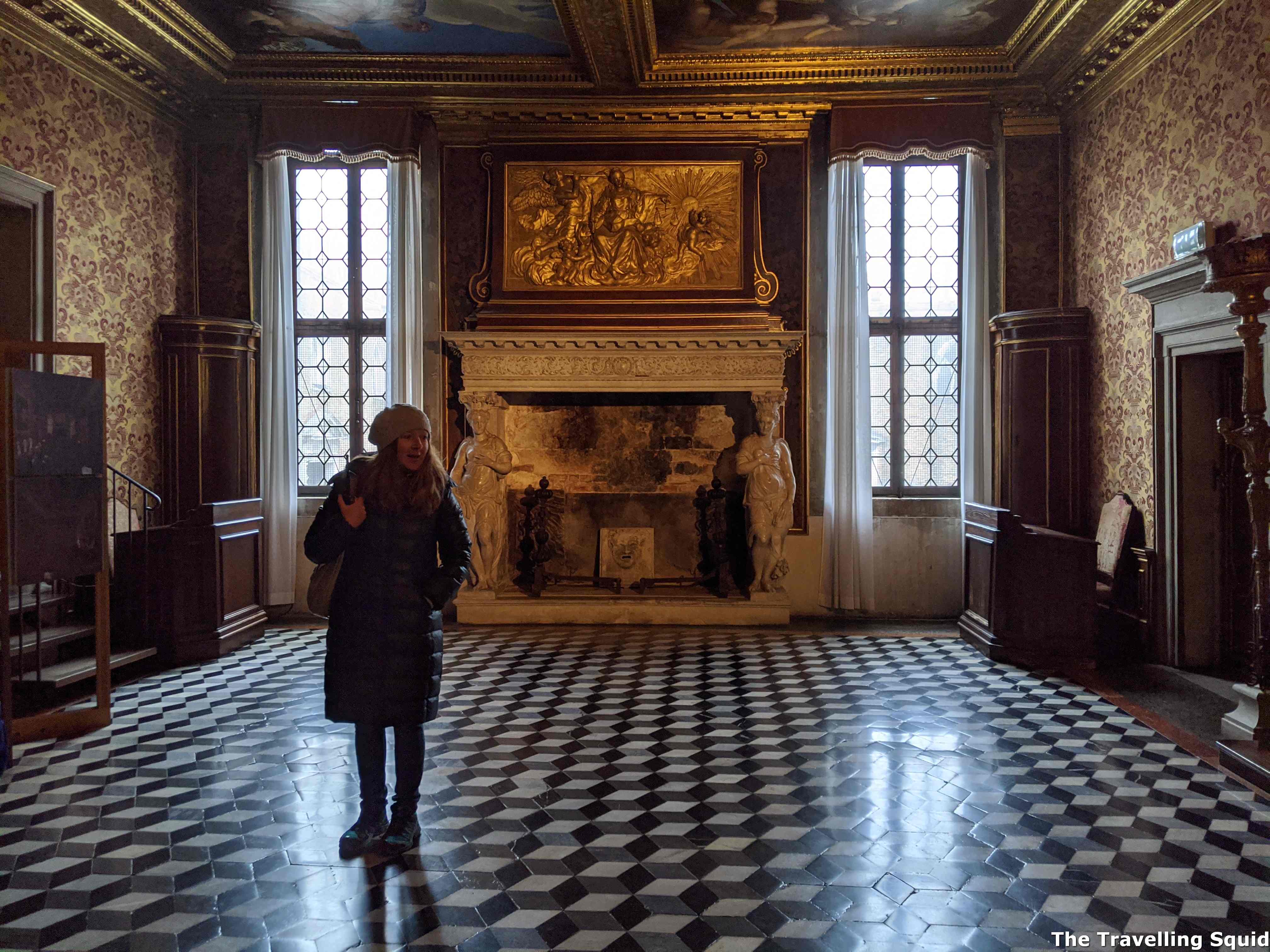
If you’re looking to buy a normal ticket to the Doge’s Palace, I would recommend that you go on the secret itineraries tour of the Doges Palace instead. It cost €28 for an adult ticket , which is much higher compared to the entrance fee for other attractions in Italy, like the Milan Cathedral . But through the tour, you can learn about the workings of the Doge’s Palace, and see places which are not opened to those who purchase the normal ticket at €25. As compared to the Secret Itineraries tour, the normal ticket gives you access to the St Mark’s Museum, which according to Google, looked quite ornate. But we preferred to have a guide and it was worth it. Here’s why you should do the Secret Itineraries tour of the Doges Palace in Venice. It will take about 1hr 30 mins.
5 reasons to take the Secret Itineraries tour of the Doges Palace in Venice
1. our guide was knowledgeable and fun.
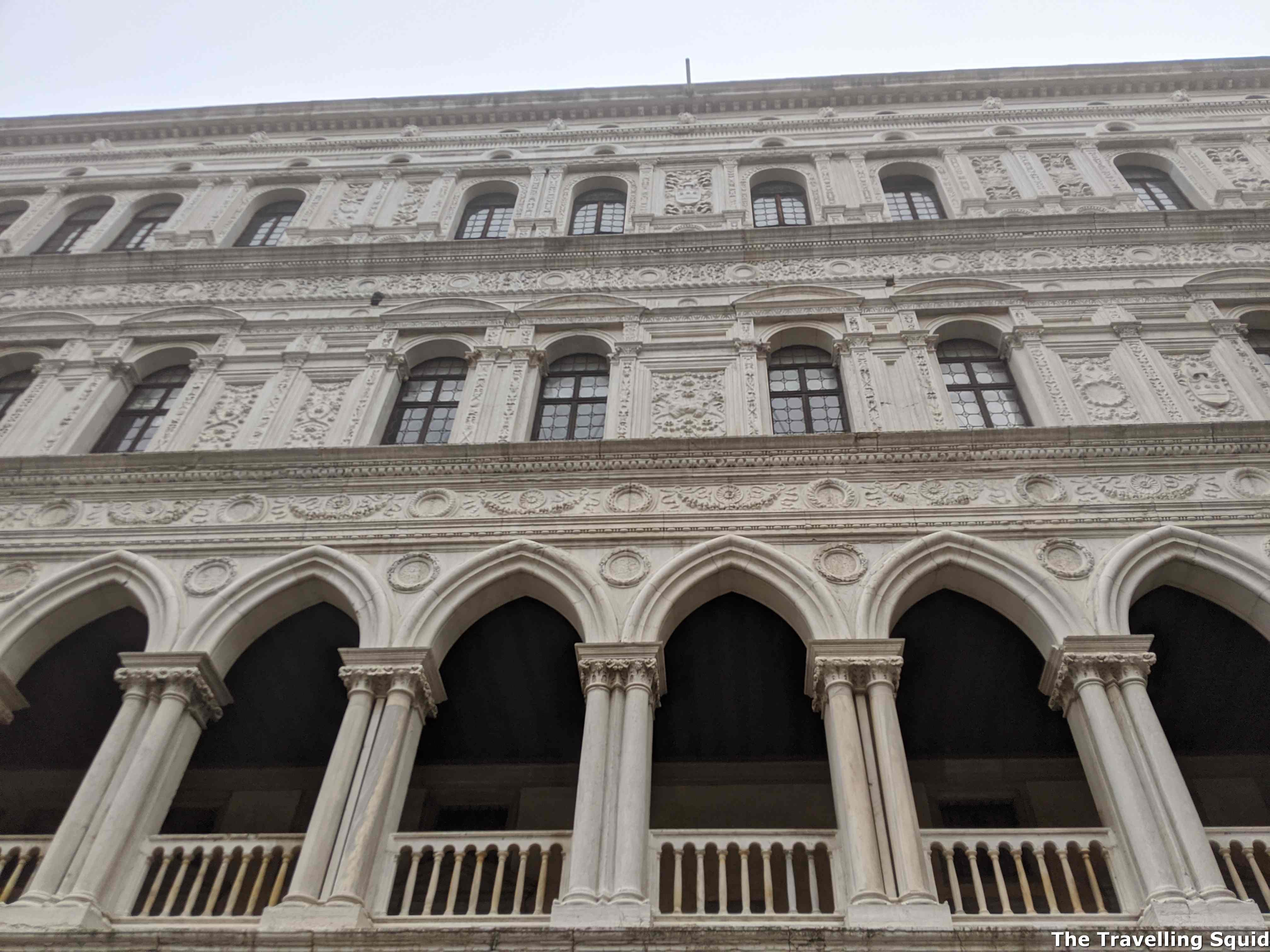
Our guide was a Venetian lady who told us interesting facts and peppered the tour with jokes along the way. She started off at the square telling us about the big rooms in the palace, which are designated for voting and for political meetings of Venetian noblemen. At one point, one of the meeting rooms was the biggest in the whole of Europe.
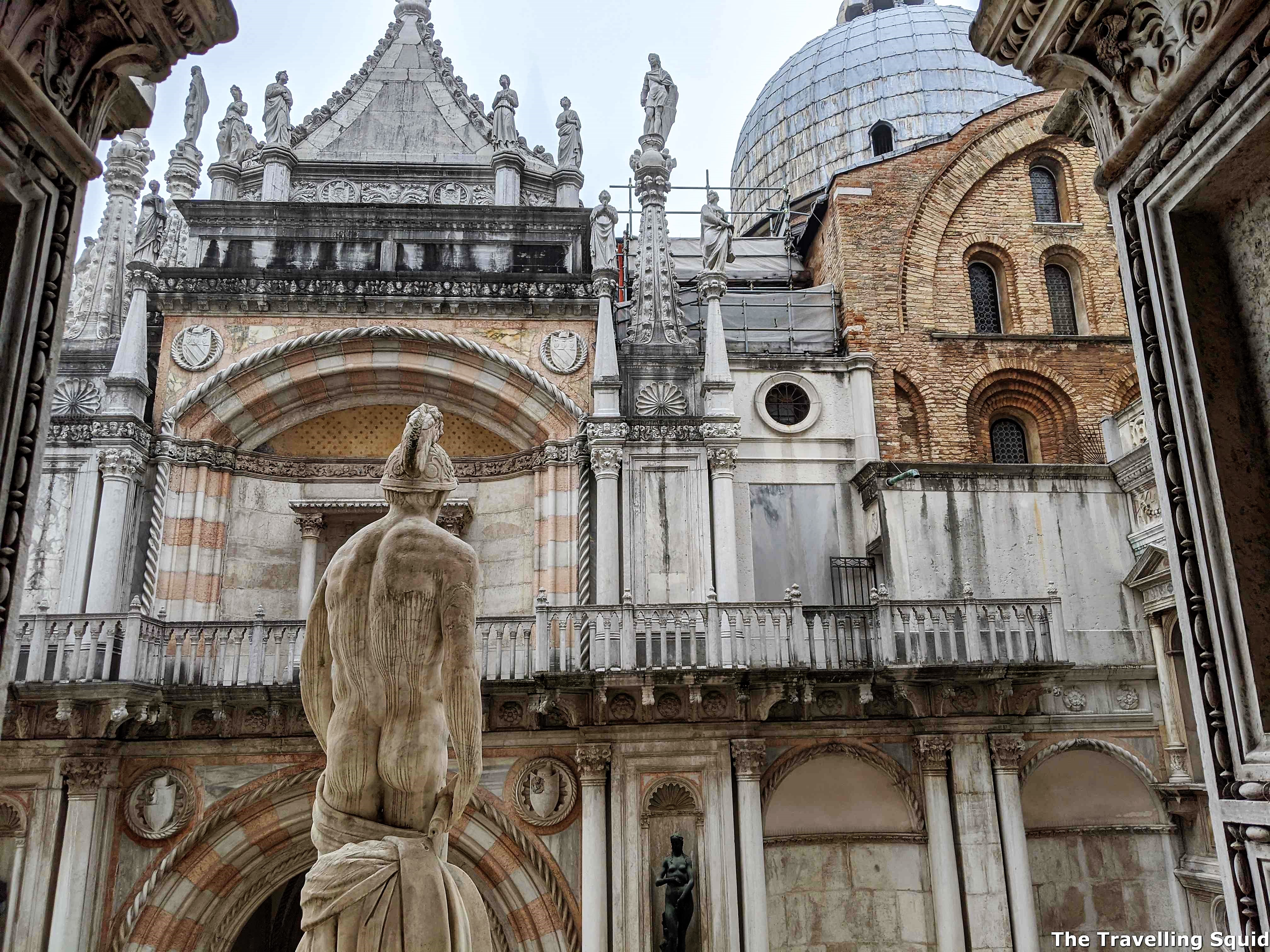
Our guide also mentioned that it was difficult for local Venetians to continue staying in Venice due to the high cost of living. In addition, there is also a high cost involved to do restoration and repair works as workers will have to take a boat over. This explains why we saw plenty of empty homes when we ventured to a more local part of the island in the south-east. It was much more enjoyable listening to our guide as opposed to simply reading the short English descriptions of the paintings.
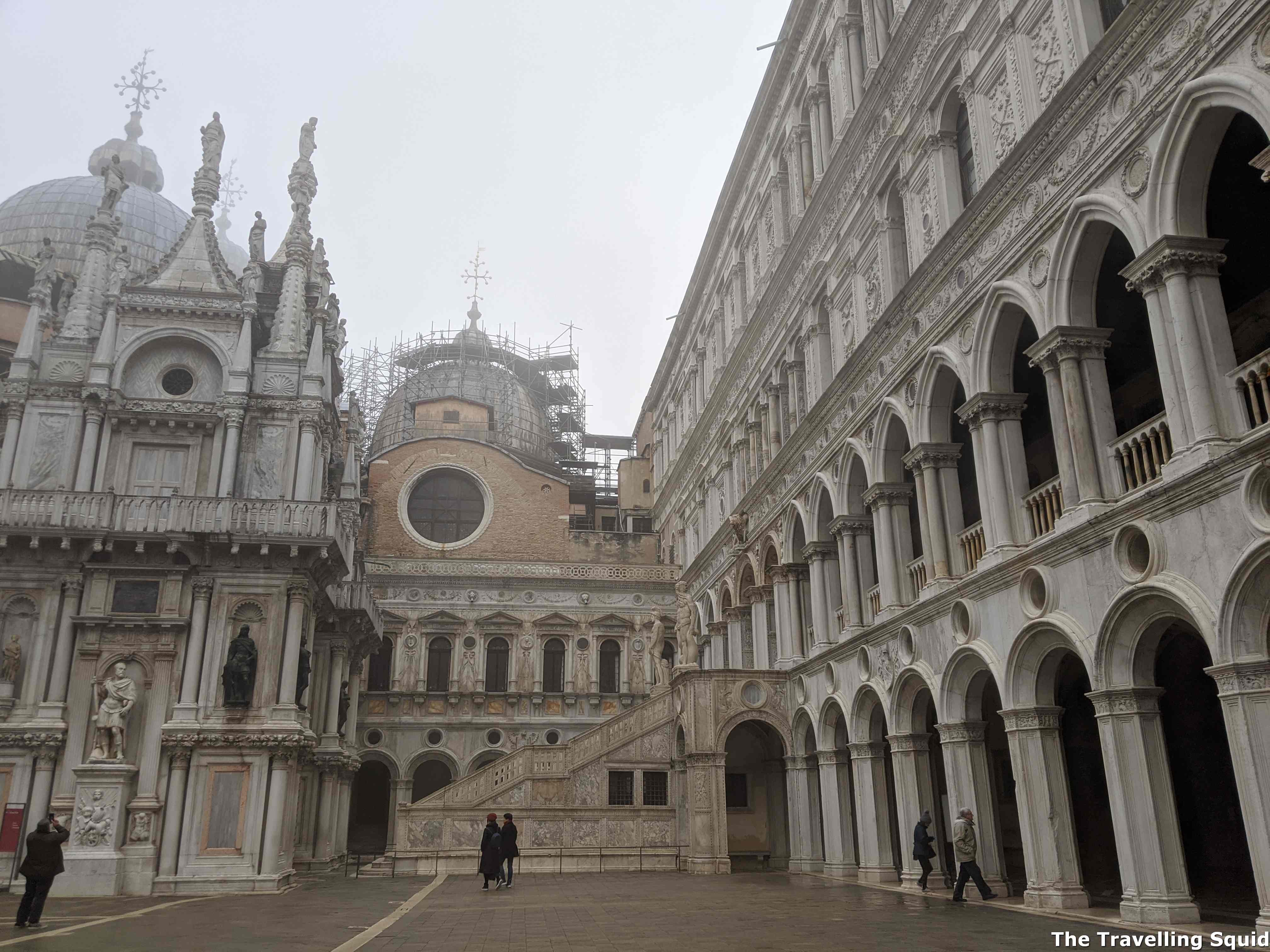
We learnt that the fall of Venice could be attributed to Napoleon , hence he is a figure not well-liked among Venetians.
2. We got to see Casanova’s cell and learn how he escaped
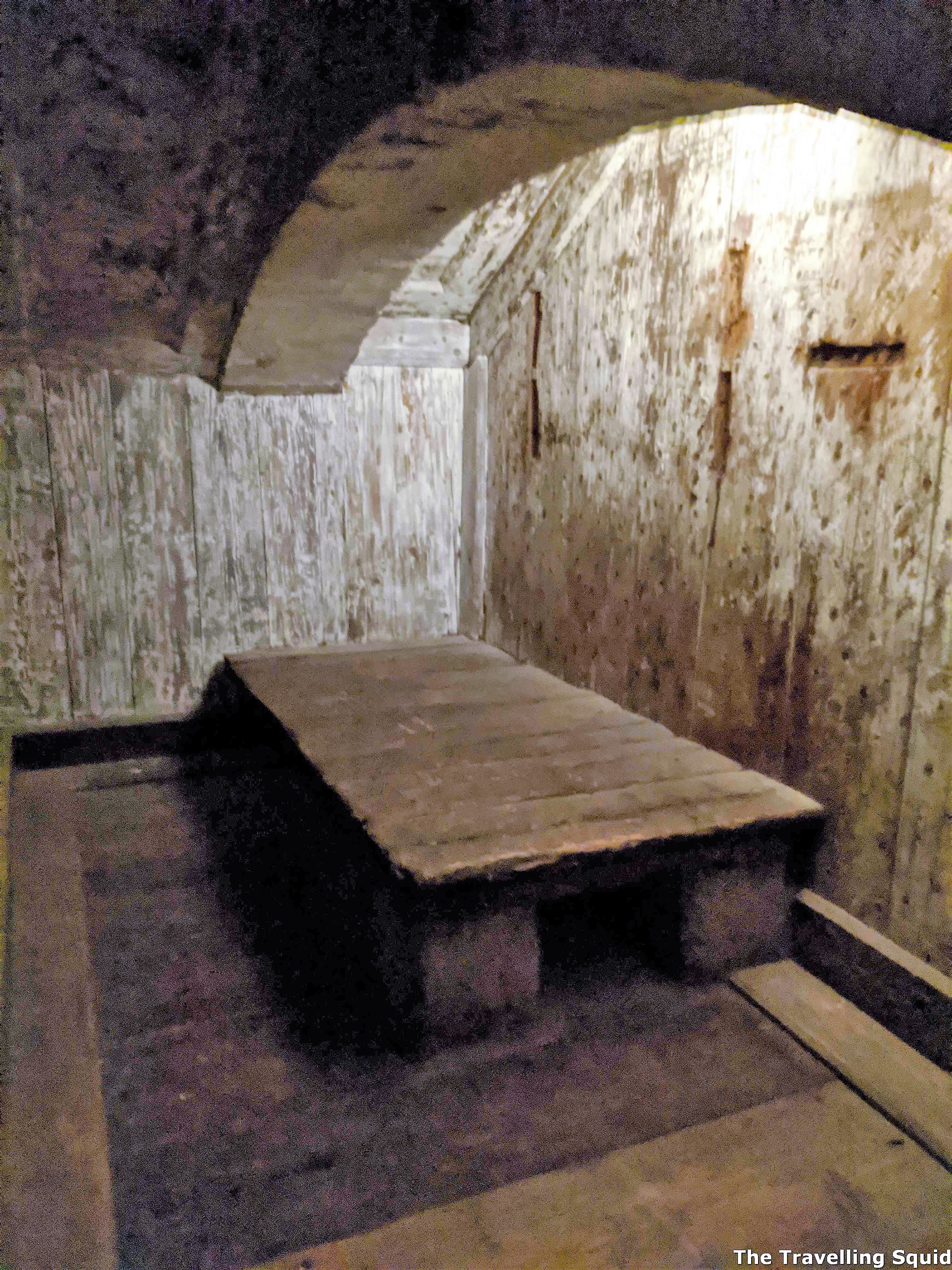
Giacomo Casanova is one of Venice’s most famous residents. He was known for his romantic liaisons with women from all walks of life, including nuns. Our guide explained that women were sent to be nuns back then out of poverty. For some, it was not of their choice. In the midst of saving them, Casanova had several affairs and was imprisoned for an affront to religion.
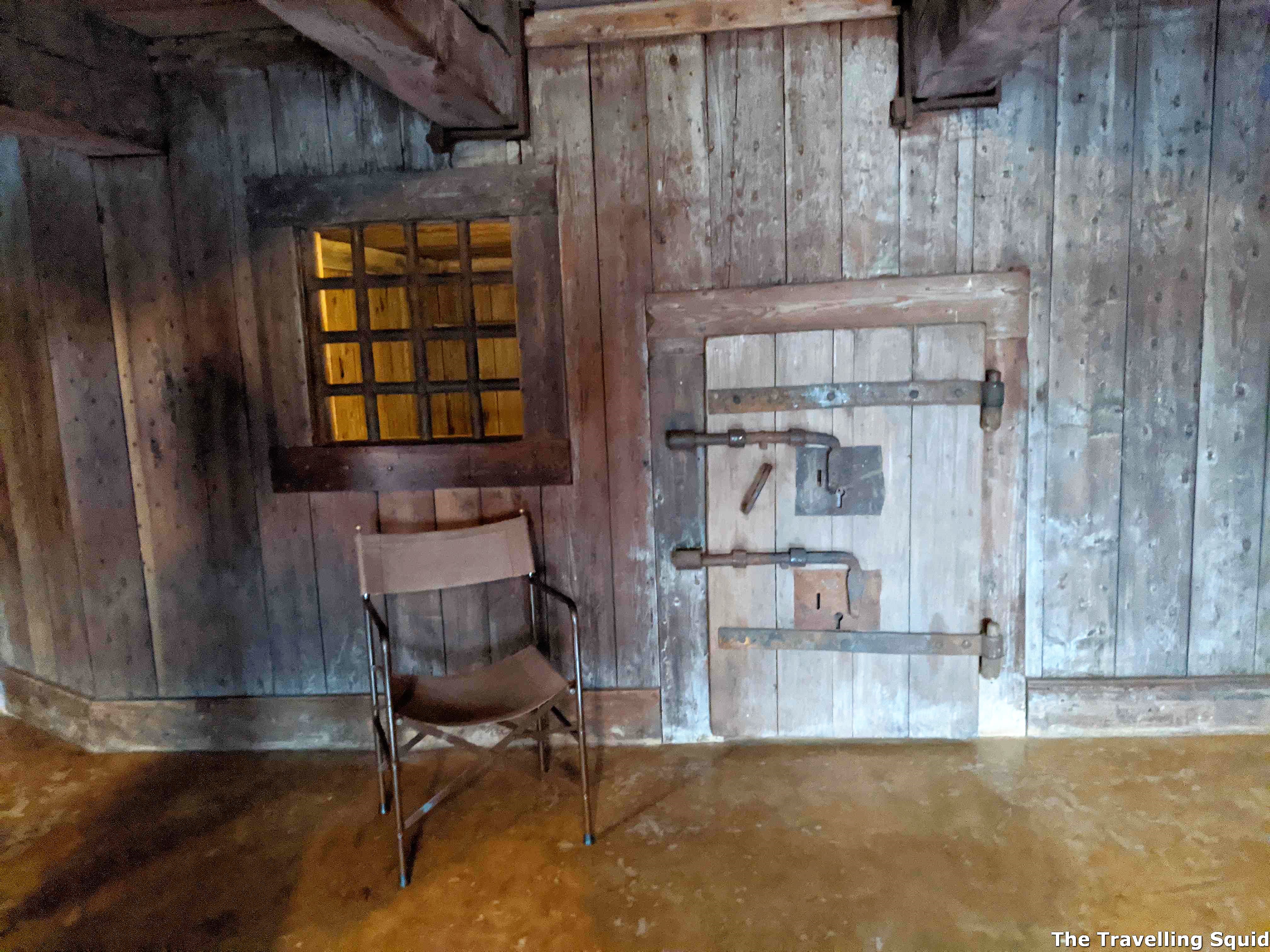
The subject of Casanova’s escape was a controversial one. It was said that during one of his walks, he found a metal spike which he brought with him back to his cell. He started digging a hole in the wall as a means of escape. But on the night before he planned his escape, he was moved to another holding cell, and had to bribe the warden of that time to cover up (the hole) literally. He was placed in another holding cell where he enlisted the help of his cellmate, Father Balbi, a renegade priest, to dig a hole for their escape.
While Casanova’s account is suspenseful, the guide said that it was to be taken with a pinch of salt, as there was no hole to be found when the cells were checked after his escape.
3. Political prisoners were left in the basement, which could flood during heavy rains
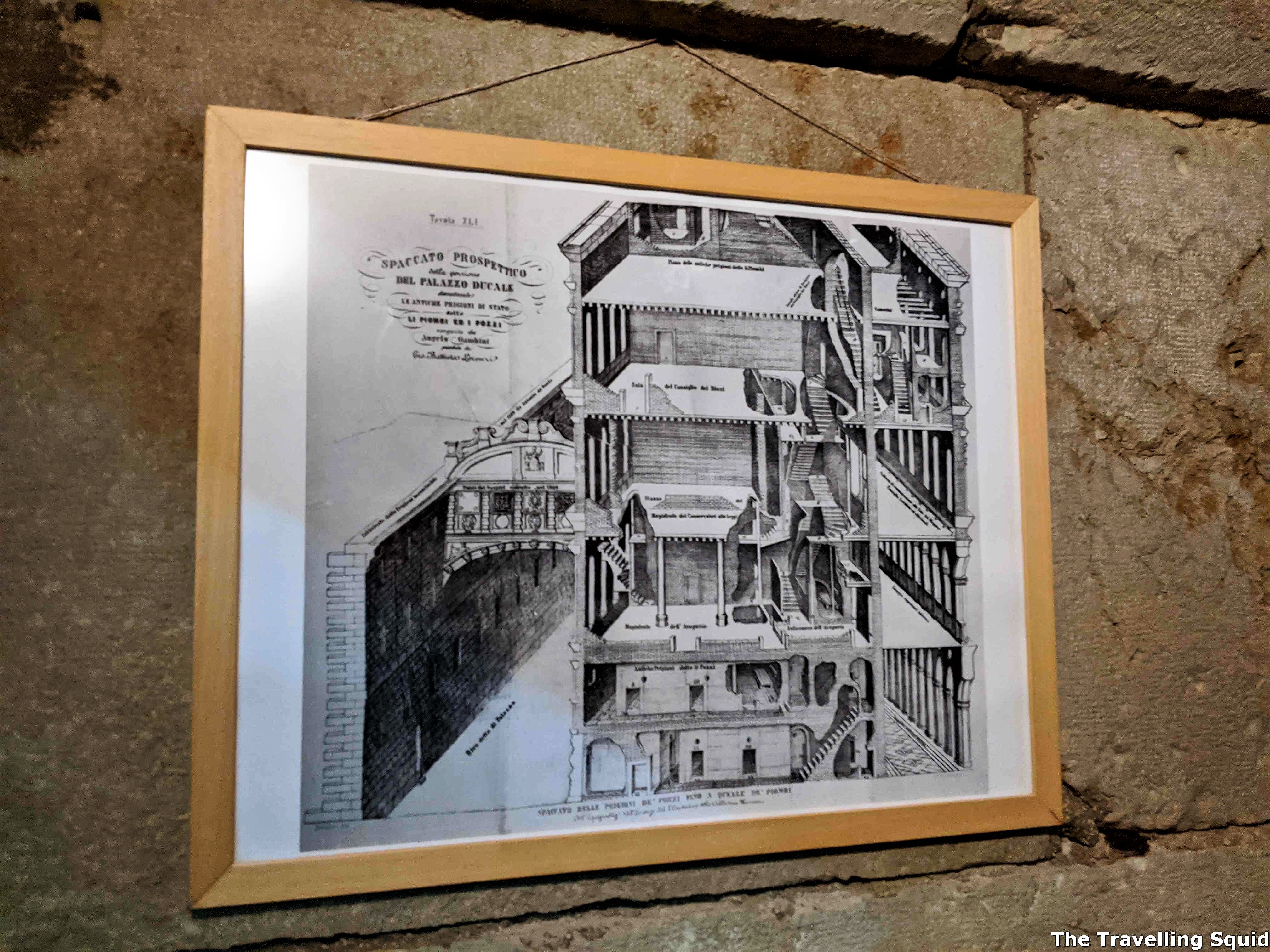
It is most unfortunate if you were convicted of treason back in those days. We were told that political prisoners, especially those who were about to be executed we placed in cells at the basement of the palace. As it rains frequently in Venice and floods often, the cells would be flooded and water levels could rise to one’s chest level. It was a dire situation especially if the cells were flooded and the prisoners had to share it with rats. According to our guide, rats outnumber the number of humans in Venice currently.
4. It is better to be a Chancellor than a Doge
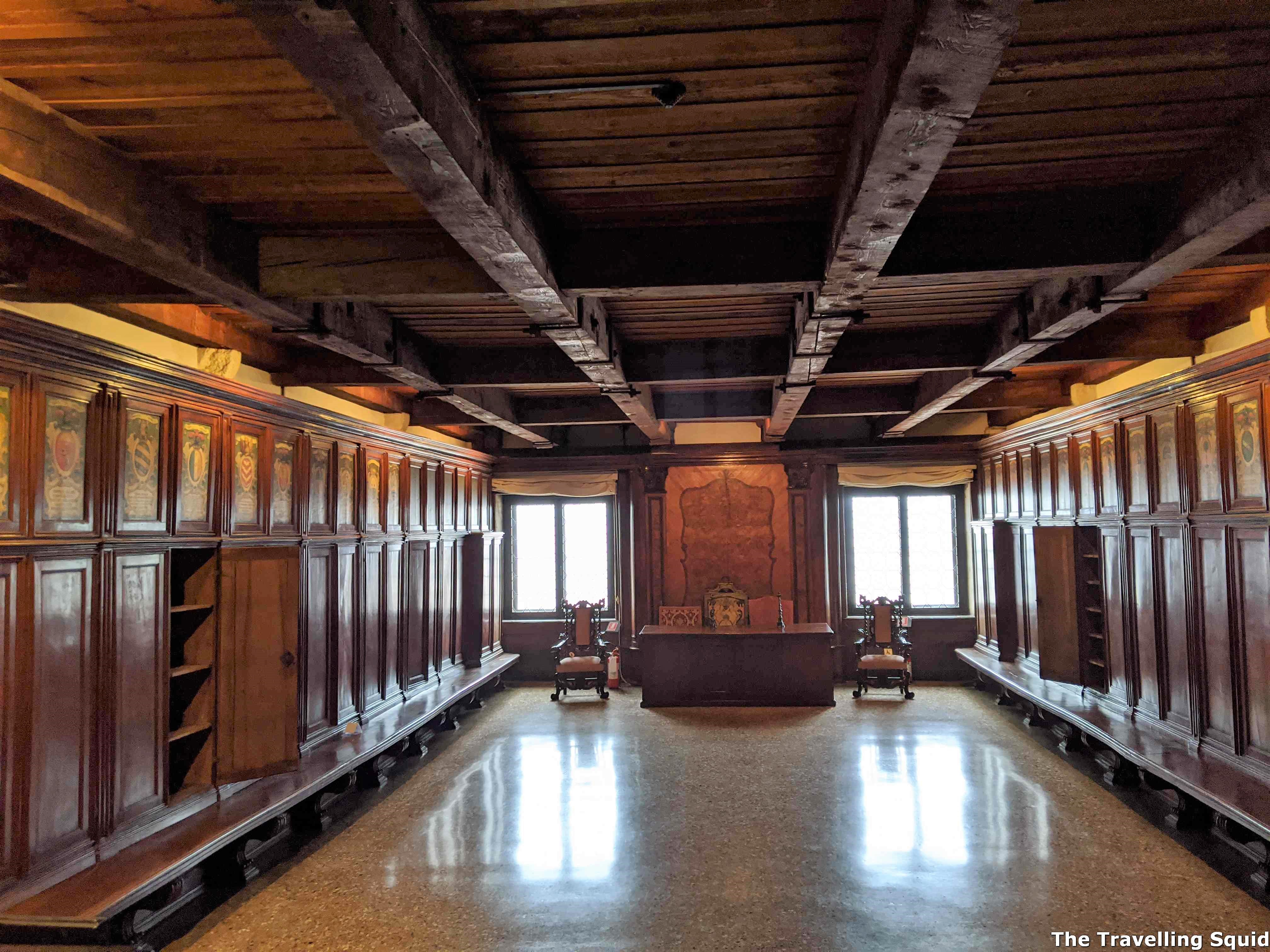
We visited the Office of the Great Chancellor, who is said to be in charge of all the archival records in Venice. The Chancellors had a nice office with wooden beams supporting it. Apparently, it could get quite hot during the summer. That said, it was still much more spacious that the prison cells below. Our guide said that it was much better to be a Chancellor as compared to being a Doge, as the Doge was expected to furnish the palace with his own wealth. In comparison, the Chancellor knew all the secrets of the city, and as a result, was paid well. His appointment was for life and his office was also quite big, by standards in the past.
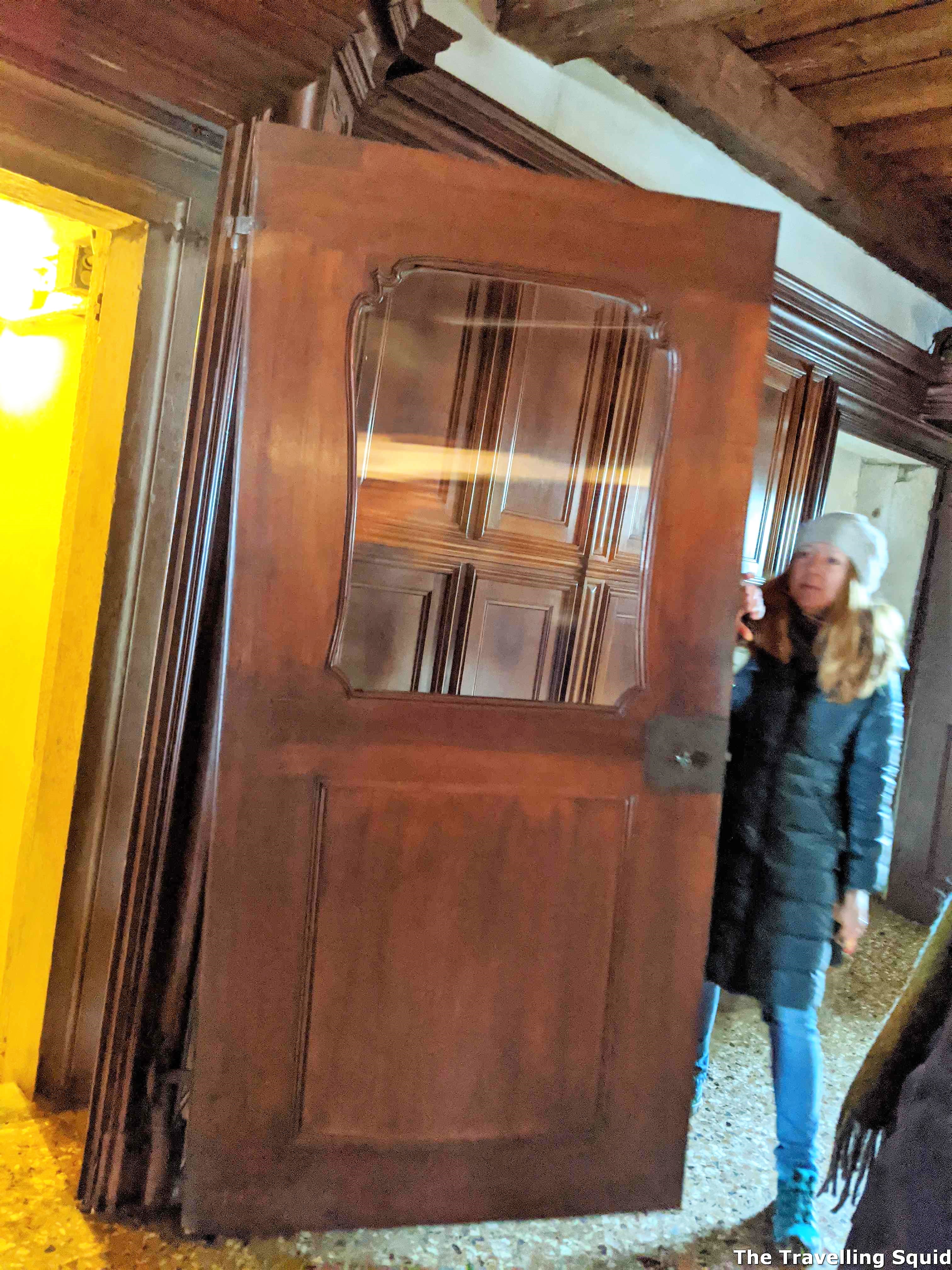

5. We learnt that a bridge built 500 years ago can be sturdier than one built 10 years ago
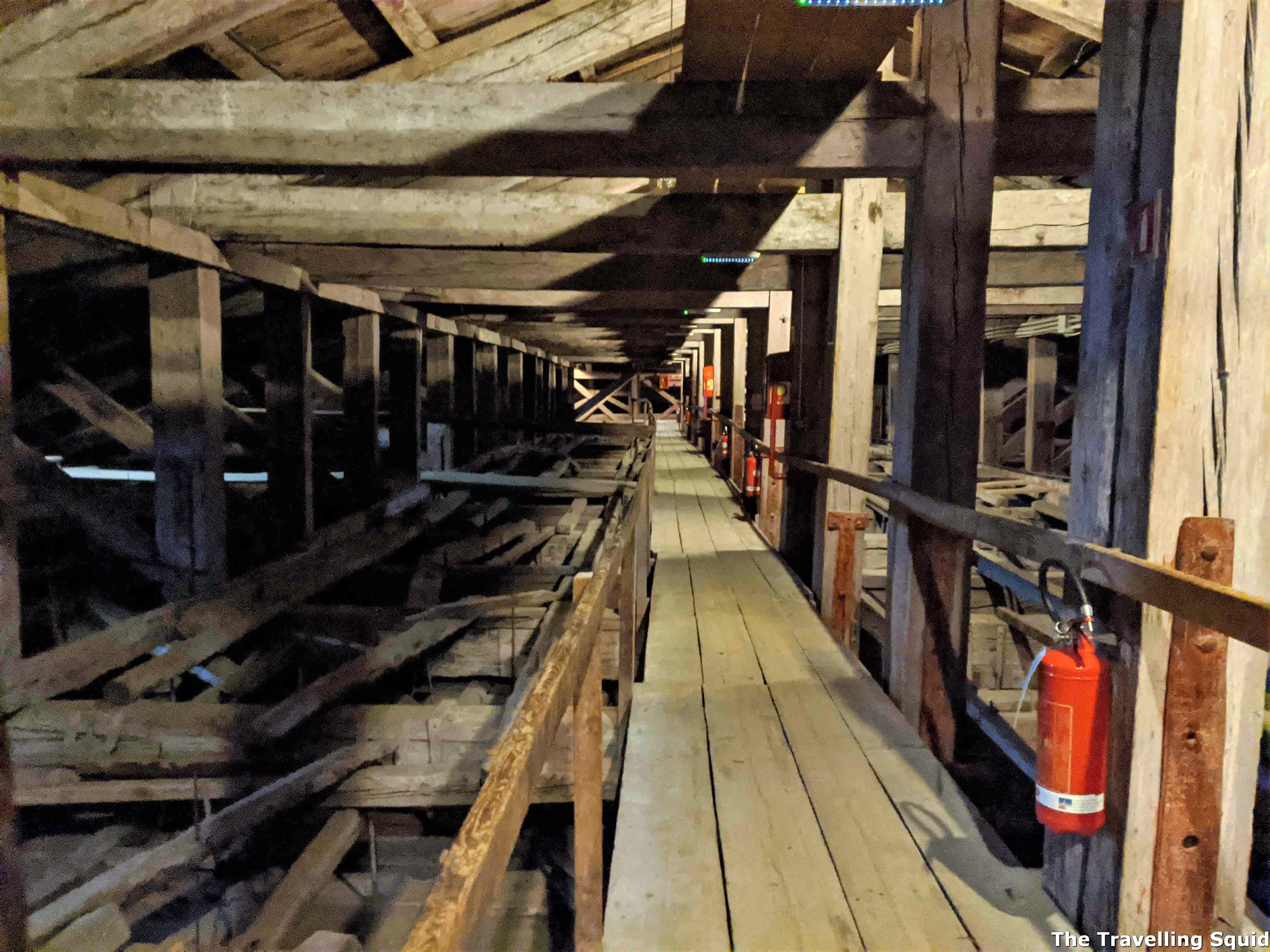
The Secret Itineraries tour led us to the attic where we could see the foundations of the palace, held steady by blocks of wood. It was then where our guide remarked that it was quite steady, as compared bridges which were built 10 years ago to serve incoming tourist traffic.
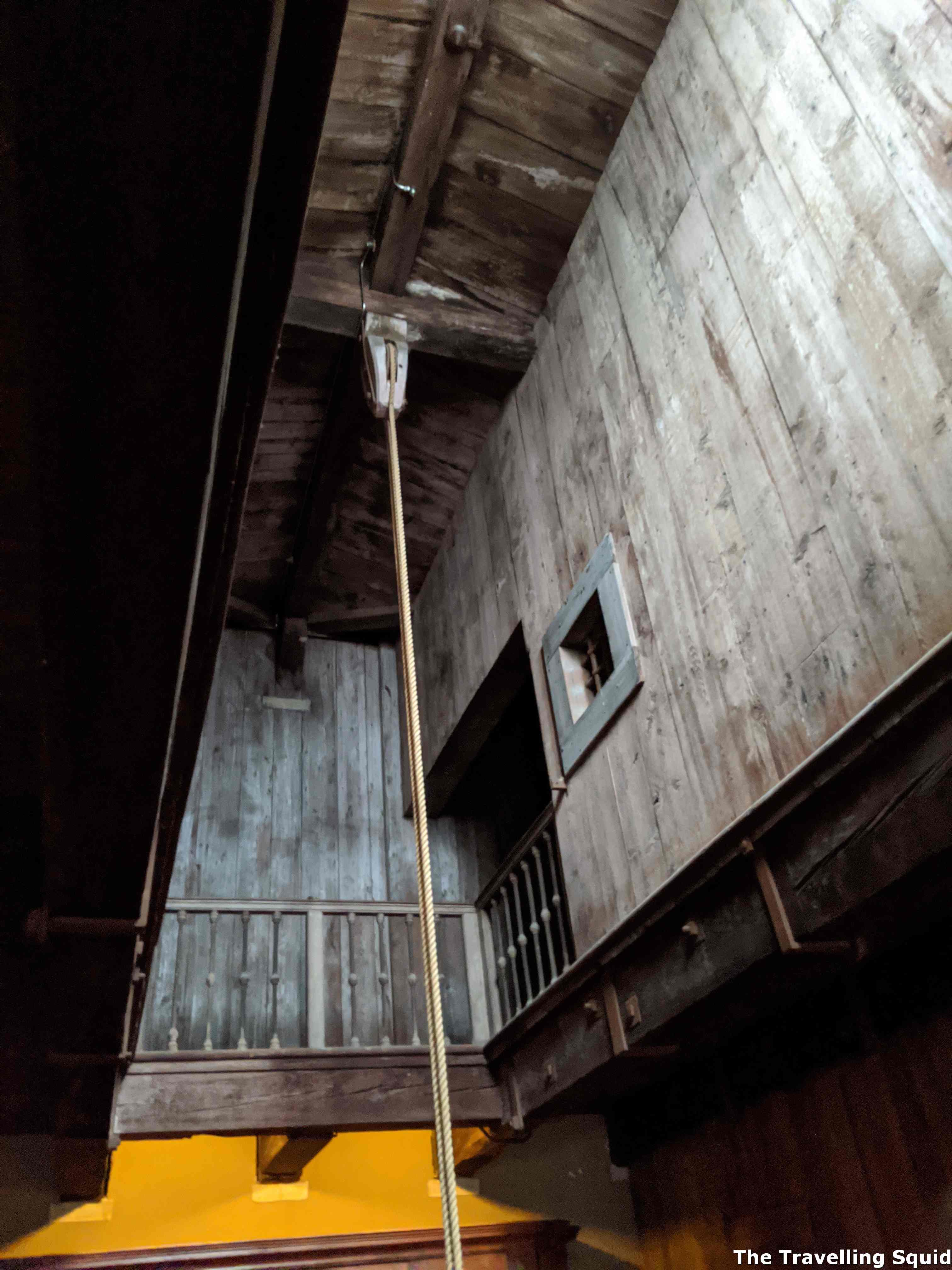
After the tour, we took a walk around the palace. The paintings and rooms in the Dodge’s Palace were impressive, decked in gold and paintings of epic battles. If the Cathedrals that we visited in Italy were meant to make people feel awe in a divine presence, the paintings and gold furnishings were meant to make guests feel impressed – it was almost intimidating. We particularly like the frescos on the floor, which were in the form of 3D shapes.
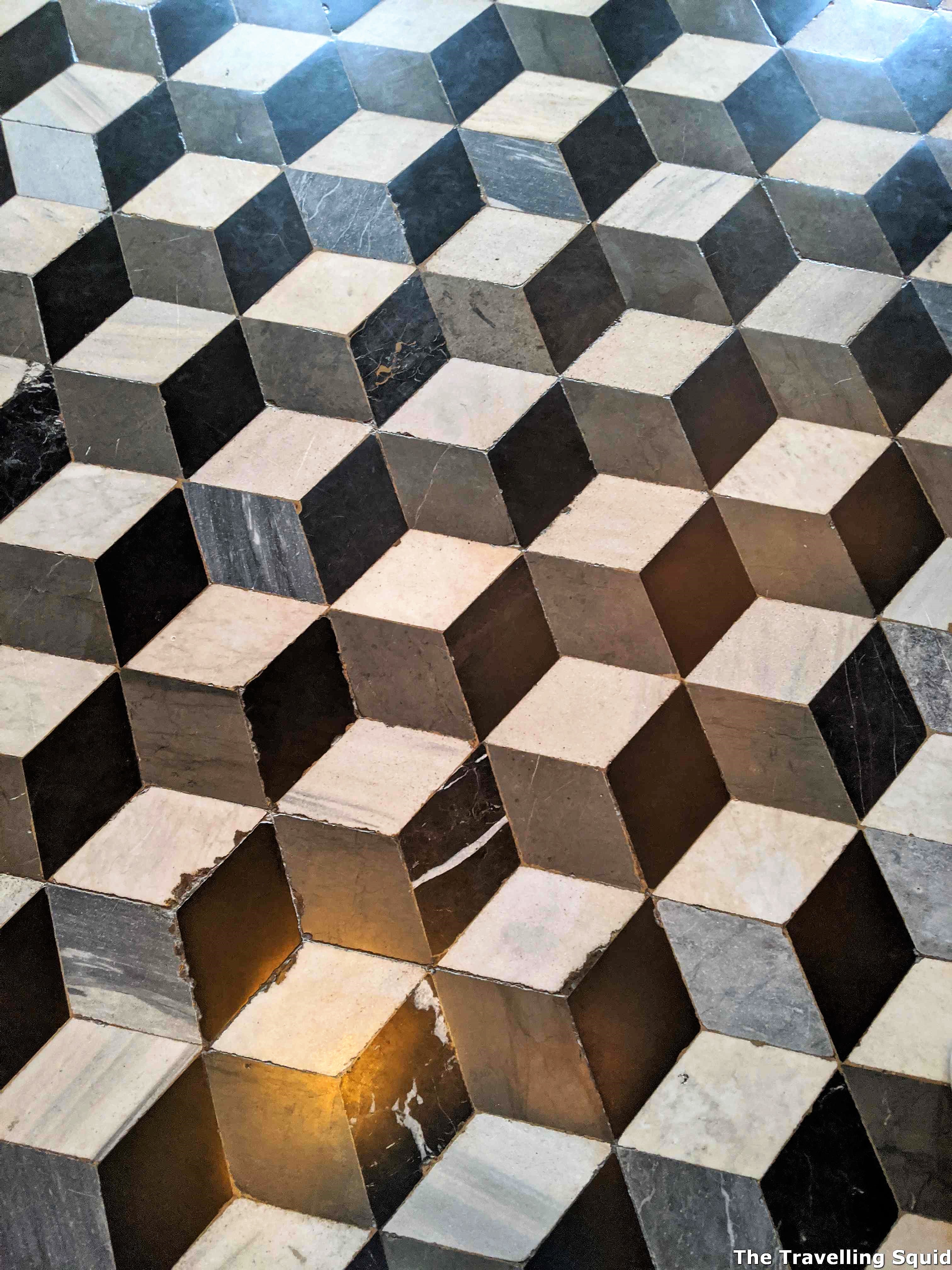
The Travelling Squid’s Take
For new visitors who are not familiar with Venice’s history, the Secret Itineraries tour will give you a glimpse into what was life in the past, away from the grandeur of the ceremonial halls. It was interesting to learn about how public servants were involved in the administration of Venetian governance, as well as experience the prison cells which used to hold people convicted of political crimes and Casanova.
More from The Travelling Squid

© 2024 The Travelling Squid
Powered by Pinboard Theme by One Designs and WordPress
Time in Elektrostal , Moscow Oblast, Russia now
- Tokyo 09:21PM
- Beijing 08:21PM
- Kyiv 03:21PM
- Paris 02:21PM
- London 01:21PM
- New York 08:21AM
- Los Angeles 05:21AM
Time zone info for Elektrostal
- The time in Elektrostal is 8 hours ahead of the time in New York when New York is on standard time, and 7 hours ahead of the time in New York when New York is on daylight saving time.
- Elektrostal does not change between summer time and winter time.
- The IANA time zone identifier for Elektrostal is Europe/Moscow.
Time difference from Elektrostal
Sunrise, sunset, day length and solar time for elektrostal.
- Sunrise: 03:44AM
- Sunset: 09:04PM
- Day length: 17h 20m
- Solar noon: 12:24PM
- The current local time in Elektrostal is 24 minutes ahead of apparent solar time.
Elektrostal on the map
- Location: Moscow Oblast, Russia
- Latitude: 55.79. Longitude: 38.46
- Population: 144,000
Best restaurants in Elektrostal
- #1 Tolsty medved - Steakhouses food
- #2 Ermitazh - European and japanese food
- #3 Pechka - European and french food
Find best places to eat in Elektrostal
- Best pizza restaurants in Elektrostal
- Best restaurants with desserts in Elektrostal
- Best dinner restaurants in Elektrostal
The 50 largest cities in Russia

- Bahasa Indonesia
- Eastern Europe
- Moscow Oblast
Elektrostal
Elektrostal Localisation : Country Russia , Oblast Moscow Oblast . Available Information : Geographical coordinates , Population, Area, Altitude, Weather and Hotel . Nearby cities and villages : Noginsk , Pavlovsky Posad and Staraya Kupavna .
Information
Find all the information of Elektrostal or click on the section of your choice in the left menu.
- Update data
Elektrostal Demography
Information on the people and the population of Elektrostal.
Elektrostal Geography
Geographic Information regarding City of Elektrostal .
Elektrostal Distance
Distance (in kilometers) between Elektrostal and the biggest cities of Russia.
Elektrostal Map
Locate simply the city of Elektrostal through the card, map and satellite image of the city.
Elektrostal Nearby cities and villages
Elektrostal weather.
Weather forecast for the next coming days and current time of Elektrostal.
Elektrostal Sunrise and sunset
Find below the times of sunrise and sunset calculated 7 days to Elektrostal.
Elektrostal Hotel
Our team has selected for you a list of hotel in Elektrostal classified by value for money. Book your hotel room at the best price.
Elektrostal Nearby
Below is a list of activities and point of interest in Elektrostal and its surroundings.
Elektrostal Page

- Information /Russian-Federation--Moscow-Oblast--Elektrostal#info
- Demography /Russian-Federation--Moscow-Oblast--Elektrostal#demo
- Geography /Russian-Federation--Moscow-Oblast--Elektrostal#geo
- Distance /Russian-Federation--Moscow-Oblast--Elektrostal#dist1
- Map /Russian-Federation--Moscow-Oblast--Elektrostal#map
- Nearby cities and villages /Russian-Federation--Moscow-Oblast--Elektrostal#dist2
- Weather /Russian-Federation--Moscow-Oblast--Elektrostal#weather
- Sunrise and sunset /Russian-Federation--Moscow-Oblast--Elektrostal#sun
- Hotel /Russian-Federation--Moscow-Oblast--Elektrostal#hotel
- Nearby /Russian-Federation--Moscow-Oblast--Elektrostal#around
- Page /Russian-Federation--Moscow-Oblast--Elektrostal#page
- Terms of Use
- Copyright © 2024 DB-City - All rights reserved
- Change Ad Consent Do not sell my data

40 Facts About Elektrostal
Written by Lanette Mayes
Modified & Updated: 01 Jun 2024
Reviewed by Jessica Corbett

Elektrostal is a vibrant city located in the Moscow Oblast region of Russia. With a rich history, stunning architecture, and a thriving community, Elektrostal is a city that has much to offer. Whether you are a history buff, nature enthusiast, or simply curious about different cultures, Elektrostal is sure to captivate you.
This article will provide you with 40 fascinating facts about Elektrostal, giving you a better understanding of why this city is worth exploring. From its origins as an industrial hub to its modern-day charm, we will delve into the various aspects that make Elektrostal a unique and must-visit destination.
So, join us as we uncover the hidden treasures of Elektrostal and discover what makes this city a true gem in the heart of Russia.
Key Takeaways:
- Elektrostal, known as the “Motor City of Russia,” is a vibrant and growing city with a rich industrial history, offering diverse cultural experiences and a strong commitment to environmental sustainability.
- With its convenient location near Moscow, Elektrostal provides a picturesque landscape, vibrant nightlife, and a range of recreational activities, making it an ideal destination for residents and visitors alike.
Known as the “Motor City of Russia.”
Elektrostal, a city located in the Moscow Oblast region of Russia, earned the nickname “Motor City” due to its significant involvement in the automotive industry.
Home to the Elektrostal Metallurgical Plant.
Elektrostal is renowned for its metallurgical plant, which has been producing high-quality steel and alloys since its establishment in 1916.
Boasts a rich industrial heritage.
Elektrostal has a long history of industrial development, contributing to the growth and progress of the region.
Founded in 1916.
The city of Elektrostal was founded in 1916 as a result of the construction of the Elektrostal Metallurgical Plant.
Located approximately 50 kilometers east of Moscow.
Elektrostal is situated in close proximity to the Russian capital, making it easily accessible for both residents and visitors.
Known for its vibrant cultural scene.
Elektrostal is home to several cultural institutions, including museums, theaters, and art galleries that showcase the city’s rich artistic heritage.
A popular destination for nature lovers.
Surrounded by picturesque landscapes and forests, Elektrostal offers ample opportunities for outdoor activities such as hiking, camping, and birdwatching.
Hosts the annual Elektrostal City Day celebrations.
Every year, Elektrostal organizes festive events and activities to celebrate its founding, bringing together residents and visitors in a spirit of unity and joy.
Has a population of approximately 160,000 people.
Elektrostal is home to a diverse and vibrant community of around 160,000 residents, contributing to its dynamic atmosphere.
Boasts excellent education facilities.
The city is known for its well-established educational institutions, providing quality education to students of all ages.
A center for scientific research and innovation.
Elektrostal serves as an important hub for scientific research, particularly in the fields of metallurgy , materials science, and engineering.
Surrounded by picturesque lakes.
The city is blessed with numerous beautiful lakes , offering scenic views and recreational opportunities for locals and visitors alike.
Well-connected transportation system.
Elektrostal benefits from an efficient transportation network, including highways, railways, and public transportation options, ensuring convenient travel within and beyond the city.
Famous for its traditional Russian cuisine.
Food enthusiasts can indulge in authentic Russian dishes at numerous restaurants and cafes scattered throughout Elektrostal.
Home to notable architectural landmarks.
Elektrostal boasts impressive architecture, including the Church of the Transfiguration of the Lord and the Elektrostal Palace of Culture.
Offers a wide range of recreational facilities.
Residents and visitors can enjoy various recreational activities, such as sports complexes, swimming pools, and fitness centers, enhancing the overall quality of life.
Provides a high standard of healthcare.
Elektrostal is equipped with modern medical facilities, ensuring residents have access to quality healthcare services.
Home to the Elektrostal History Museum.
The Elektrostal History Museum showcases the city’s fascinating past through exhibitions and displays.
A hub for sports enthusiasts.
Elektrostal is passionate about sports, with numerous stadiums, arenas, and sports clubs offering opportunities for athletes and spectators.
Celebrates diverse cultural festivals.
Throughout the year, Elektrostal hosts a variety of cultural festivals, celebrating different ethnicities, traditions, and art forms.
Electric power played a significant role in its early development.
Elektrostal owes its name and initial growth to the establishment of electric power stations and the utilization of electricity in the industrial sector.
Boasts a thriving economy.
The city’s strong industrial base, coupled with its strategic location near Moscow, has contributed to Elektrostal’s prosperous economic status.
Houses the Elektrostal Drama Theater.
The Elektrostal Drama Theater is a cultural centerpiece, attracting theater enthusiasts from far and wide.
Popular destination for winter sports.
Elektrostal’s proximity to ski resorts and winter sport facilities makes it a favorite destination for skiing, snowboarding, and other winter activities.
Promotes environmental sustainability.
Elektrostal prioritizes environmental protection and sustainability, implementing initiatives to reduce pollution and preserve natural resources.
Home to renowned educational institutions.
Elektrostal is known for its prestigious schools and universities, offering a wide range of academic programs to students.
Committed to cultural preservation.
The city values its cultural heritage and takes active steps to preserve and promote traditional customs, crafts, and arts.
Hosts an annual International Film Festival.
The Elektrostal International Film Festival attracts filmmakers and cinema enthusiasts from around the world, showcasing a diverse range of films.
Encourages entrepreneurship and innovation.
Elektrostal supports aspiring entrepreneurs and fosters a culture of innovation, providing opportunities for startups and business development .
Offers a range of housing options.
Elektrostal provides diverse housing options, including apartments, houses, and residential complexes, catering to different lifestyles and budgets.
Home to notable sports teams.
Elektrostal is proud of its sports legacy , with several successful sports teams competing at regional and national levels.
Boasts a vibrant nightlife scene.
Residents and visitors can enjoy a lively nightlife in Elektrostal, with numerous bars, clubs, and entertainment venues.
Promotes cultural exchange and international relations.
Elektrostal actively engages in international partnerships, cultural exchanges, and diplomatic collaborations to foster global connections.
Surrounded by beautiful nature reserves.
Nearby nature reserves, such as the Barybino Forest and Luchinskoye Lake, offer opportunities for nature enthusiasts to explore and appreciate the region’s biodiversity.
Commemorates historical events.
The city pays tribute to significant historical events through memorials, monuments, and exhibitions, ensuring the preservation of collective memory.
Promotes sports and youth development.
Elektrostal invests in sports infrastructure and programs to encourage youth participation, health, and physical fitness.
Hosts annual cultural and artistic festivals.
Throughout the year, Elektrostal celebrates its cultural diversity through festivals dedicated to music, dance, art, and theater.
Provides a picturesque landscape for photography enthusiasts.
The city’s scenic beauty, architectural landmarks, and natural surroundings make it a paradise for photographers.
Connects to Moscow via a direct train line.
The convenient train connection between Elektrostal and Moscow makes commuting between the two cities effortless.
A city with a bright future.
Elektrostal continues to grow and develop, aiming to become a model city in terms of infrastructure, sustainability, and quality of life for its residents.
In conclusion, Elektrostal is a fascinating city with a rich history and a vibrant present. From its origins as a center of steel production to its modern-day status as a hub for education and industry, Elektrostal has plenty to offer both residents and visitors. With its beautiful parks, cultural attractions, and proximity to Moscow, there is no shortage of things to see and do in this dynamic city. Whether you’re interested in exploring its historical landmarks, enjoying outdoor activities, or immersing yourself in the local culture, Elektrostal has something for everyone. So, next time you find yourself in the Moscow region, don’t miss the opportunity to discover the hidden gems of Elektrostal.
Q: What is the population of Elektrostal?
A: As of the latest data, the population of Elektrostal is approximately XXXX.
Q: How far is Elektrostal from Moscow?
A: Elektrostal is located approximately XX kilometers away from Moscow.
Q: Are there any famous landmarks in Elektrostal?
A: Yes, Elektrostal is home to several notable landmarks, including XXXX and XXXX.
Q: What industries are prominent in Elektrostal?
A: Elektrostal is known for its steel production industry and is also a center for engineering and manufacturing.
Q: Are there any universities or educational institutions in Elektrostal?
A: Yes, Elektrostal is home to XXXX University and several other educational institutions.
Q: What are some popular outdoor activities in Elektrostal?
A: Elektrostal offers several outdoor activities, such as hiking, cycling, and picnicking in its beautiful parks.
Q: Is Elektrostal well-connected in terms of transportation?
A: Yes, Elektrostal has good transportation links, including trains and buses, making it easily accessible from nearby cities.
Q: Are there any annual events or festivals in Elektrostal?
A: Yes, Elektrostal hosts various events and festivals throughout the year, including XXXX and XXXX.
Elektrostal's fascinating history, vibrant culture, and promising future make it a city worth exploring. For more captivating facts about cities around the world, discover the unique characteristics that define each city . Uncover the hidden gems of Moscow Oblast through our in-depth look at Kolomna. Lastly, dive into the rich industrial heritage of Teesside, a thriving industrial center with its own story to tell.
Was this page helpful?
Our commitment to delivering trustworthy and engaging content is at the heart of what we do. Each fact on our site is contributed by real users like you, bringing a wealth of diverse insights and information. To ensure the highest standards of accuracy and reliability, our dedicated editors meticulously review each submission. This process guarantees that the facts we share are not only fascinating but also credible. Trust in our commitment to quality and authenticity as you explore and learn with us.
Share this Fact:

COMMENTS
On our Doge's Palace "Prisons and Tyranny" tour, you'll discover a darker side of Venice. You'll see the Doge's Palace's hidden torture chambers and even Casanova's jail cell. See all of the areas of the palace that are not open to the public and even cross the infamous Bridge of Sighs. If you're looking for a unique Venice ...
Discover the mysteries of the Doge's Palace in Venice with this secret itineraries tour. Skip the long line and head straight inside to explore the palace's opulent public chambers adorned with masterpieces of Renaissance art. Learn how the powerful doges ruled the Venetian Republic with an iron fist, and gain rare entry into shadowy quarters of the Piombi attic prison, where Casanova was ...
Excellent tour of Doge Palace and prison. Very knowledgeable and explained much of the great history of Venice. Saw much of the inside of the Doge Palace with beautiful paintings and architecture. Read more. Written April 18, 2024. loud998. 0 contributions. Must see in Venice.
Exclusive Alone in St. Mark's Basilica After Hours. 989. From $90. This tour takes you through the secret passages of Venice's Doge's Palace in a group of 20 max—smaller than other operators. See torture chambers, Casanova's prison cell & more.
HOW TO BOOK AND BUY BY PHONE / EMAIL. Call center +39 041 42730892. Monday to Friday 09:00-16:00, Saturday and Sunday 09:00-13:00. [email protected]. _. BOOK YOUR TOUR ONLINE >. MORE INFO ABOUT THE ITINERARY >>>. Book your ticket to join "Secret Itineraries tour" and enter the heart of the Doges' Palace. We're waiting for you!
Skip-the-line entry and guided tour of Doge's Palace. 30-minute gondola ride. Maximum group size of 20. A local, English-speaking guide. St. Mark's Basilica. ... Linking the palace to the prison cells, you'll cross the infamous Bridge of Sighs (Ponte dei Sospiri). Prisoners walked across this enclosed bridge before spending years or even ...
Open to just 20 people at a time, this exclusive tour explores secret prisons, archives, offices, and even a torture chamber in Palazzo Ducale to reveal a darker side of history. For those with an interest in art, history, literature, or scandal, the Doge's Palace is by far the most interesting building in Venice.
The prison staff will escort you to an authentic Prison Palace with cramped cells, a court, and gruesome torture chambers with real tortures and justice tools. ... Skip the Line Venice Doge's Palace and St. Mark's Basilica Tour - T23. 218. Free Cancellation; English; 2 hours; from $108.94. Price varies by group size. Wine Tastings. Venice, Veneto.
In November to March, tours could be bilingual. Because of security checks you might experience a line to get inside the Doge's Palace. You will skip the line for non reserved tickets but security check is mandatory. Save up to 12%. From $69.33 $61.01 per person. Check availability. Reserve now & pay later to book your spot and pay nothing today.
See the best of Doge's Palace in Venice on a 1.25-hour skip-the-line tour! With a priority-access ticket, you won't waste time standing in line. Walk right past the long queue with your guide, and enjoy a tour that combines the palace's magnificent public rooms with rare access to the Piombi attic prison and the Bridge of Sighs. See Italian Renaissance artwork and learn about the darker deeds ...
The New Prisons would remain in operation until 1919, surviving the Republic of Venice, the French and Austrian dominations, and to some extent the Kingdom of Italy. Visit to the Doge's Palace and Prisons Venice: tickets for the Doge's Secret Itineraries. Purchase online. Choose your preferred time.
Best ticket & tour options for Doge's Palace: Skip-the-line entrance ticket (same price as the official site and so much simpler to book). ... Dating back to the 12th century, the prison cells of Doge's Palace are composed of the Piombi, the Pozzi, and the Prigioni Nuove (New Prisons). Conditions in the prisons were truly terrible, and few ...
The Secret Itinerary through the Doge's Palace covers the rooms and chambers where the delicate work of some of the most important bodies in the Venetian administration was carried out. These spaces offer an interesting insight into and acknowledgement of the civil and political history of the Venice Republic, its public organisations, and its institutional bodies deputed to government and ...
How to Book the Doge's Palace Secret Itineraries Tour . The Secret Itineraries Tour is a guided tour and is available only with a reservation. English language guided tours are currently available several times daily. ... The Piombi are the lead-lined prison cells where prisoners who had been caught by the Council of Ten were held. These ...
Step off a gondola to the impressive sight of the Doge's Palace. Free Cancellation, 1000s of 5-star reviews, and plenty of options makes The Tour Guy an easy choice! ... If you can't wait to go behind the scenes, join our Doge's Palace Venice Tour. Book tours of the iconic royal palace and Venetian prison! The Doge's Palace, or Palazzo ...
Following the extensive conservative restoration work that has restored the original splendour of its interior, the evocative rooms of the Chiesetta and Antichiesetta del Doge are the fulcrum of a new, fascinating artistic-historical tour to discover The Doge's Hidden Treasures in the Doge's Palace.. The new itinerary, which requires reservations and a qualified guide (see general ...
5 reasons to take the Secret Itineraries tour of the Doges Palace in Venice. 1. Our guide was knowledgeable and fun. The facade of the Doge's Palace. Some parts were burnt in a fired and had to be restored, hence they look different from the rest of the building.
Highlights & Description. Avoid the queues and go inside Palazzo delle Prigioni, the prison palace overlooking the Riva degli Schiavoni waterfront. Take a guided tour of the 16th-century Venetian jail, which is connected to the Doge's Palace by the famous Bridge of Sighs. Go inside the courtroom and the cells, and learn about life inside the ...
Sunset: 08:55PM. Day length: 17h 3m. Solar noon: 12:23PM. The current local time in Elektrostal is 23 minutes ahead of apparent solar time.
Elektrostal Geography. Geographic Information regarding City of Elektrostal. Elektrostal Geographical coordinates. Latitude: 55.8, Longitude: 38.45. 55° 48′ 0″ North, 38° 27′ 0″ East. Elektrostal Area. 4,951 hectares. 49.51 km² (19.12 sq mi) Elektrostal Altitude.
40 Facts About Elektrostal. Elektrostal is a vibrant city located in the Moscow Oblast region of Russia. With a rich history, stunning architecture, and a thriving community, Elektrostal is a city that has much to offer. Whether you are a history buff, nature enthusiast, or simply curious about different cultures, Elektrostal is sure to ...
March 17, 2011. Pavel Oderov was appointed as Head of the International Business Department pursuant to a Gazprom order. Pavel Oderov was born in June 1979 in the town of Elektrostal, Moscow Oblast. He graduated from Gubkin Russian State University of Oil and Gas with an Economics degree in 2000 and a Management degree in 2002.